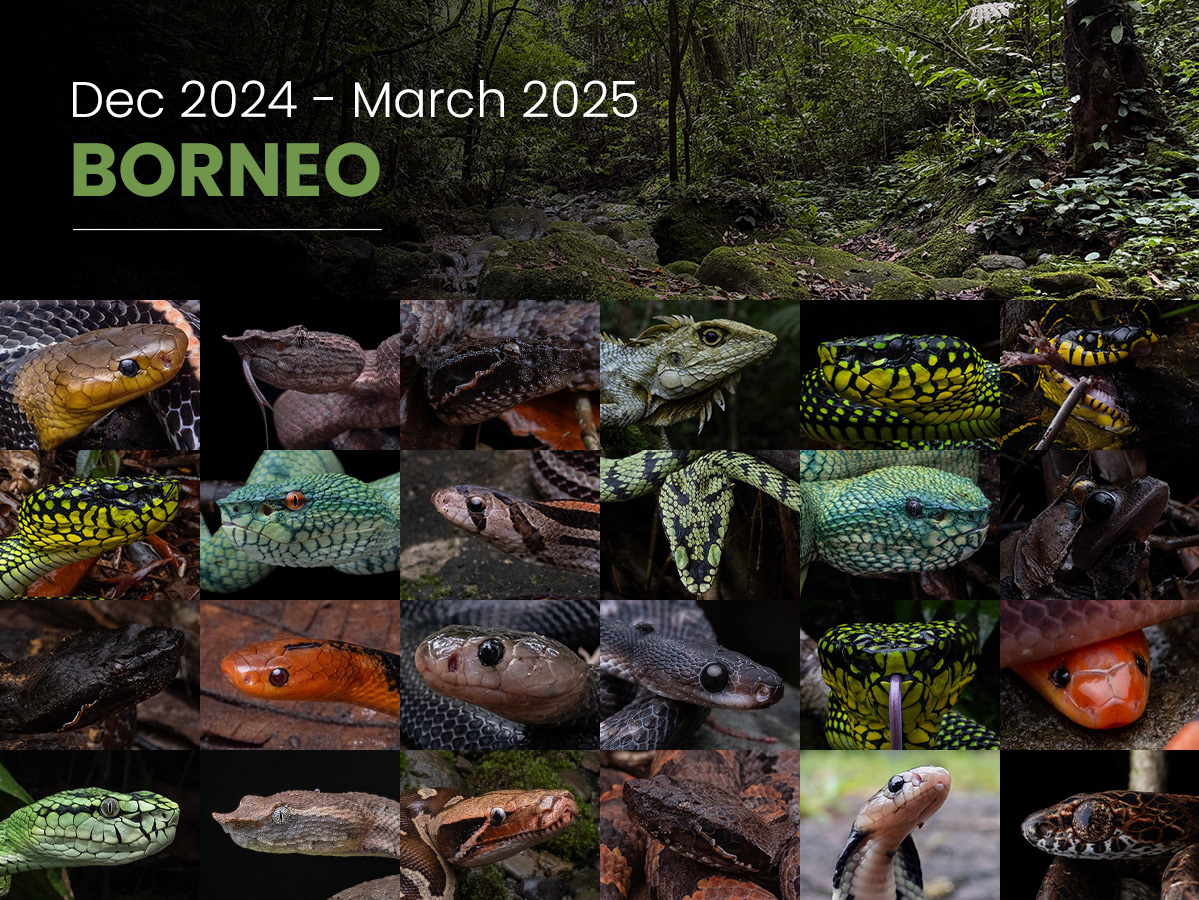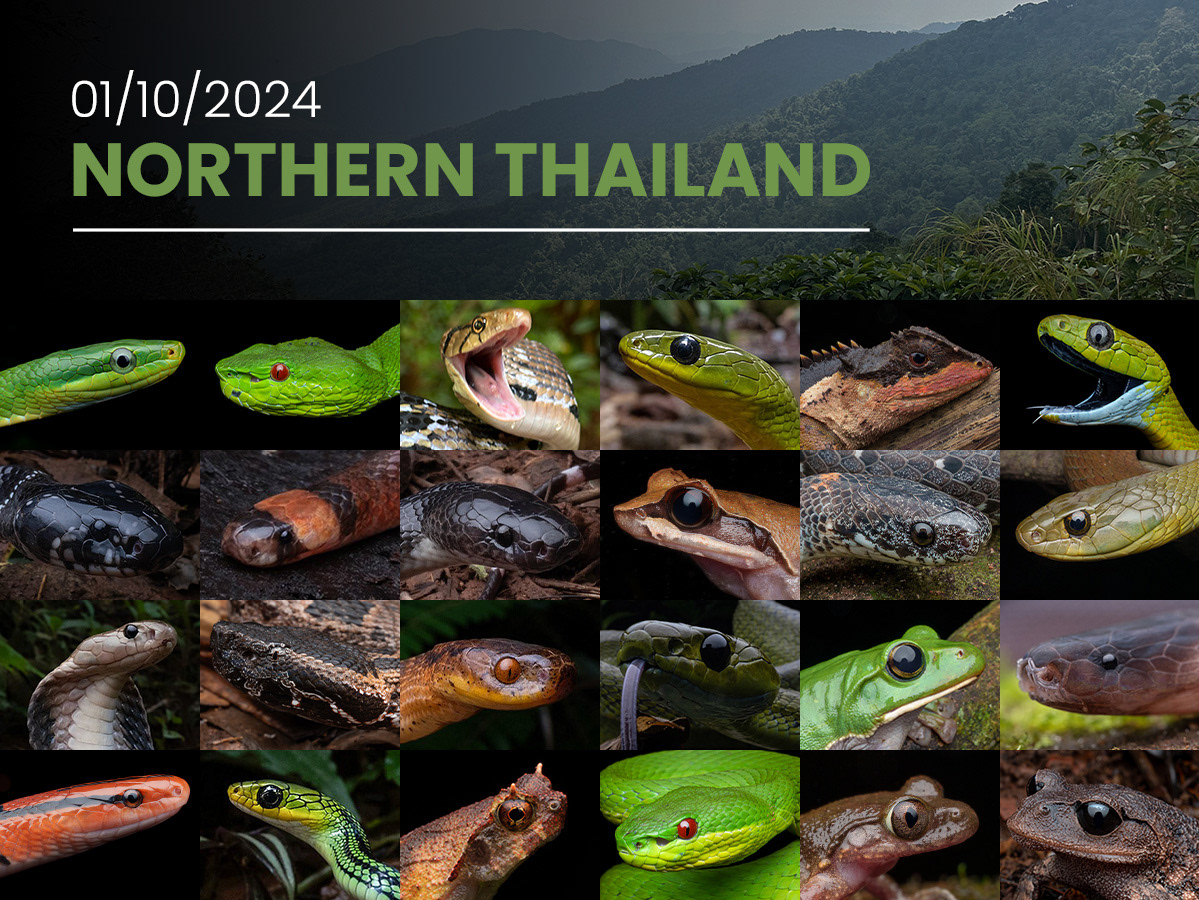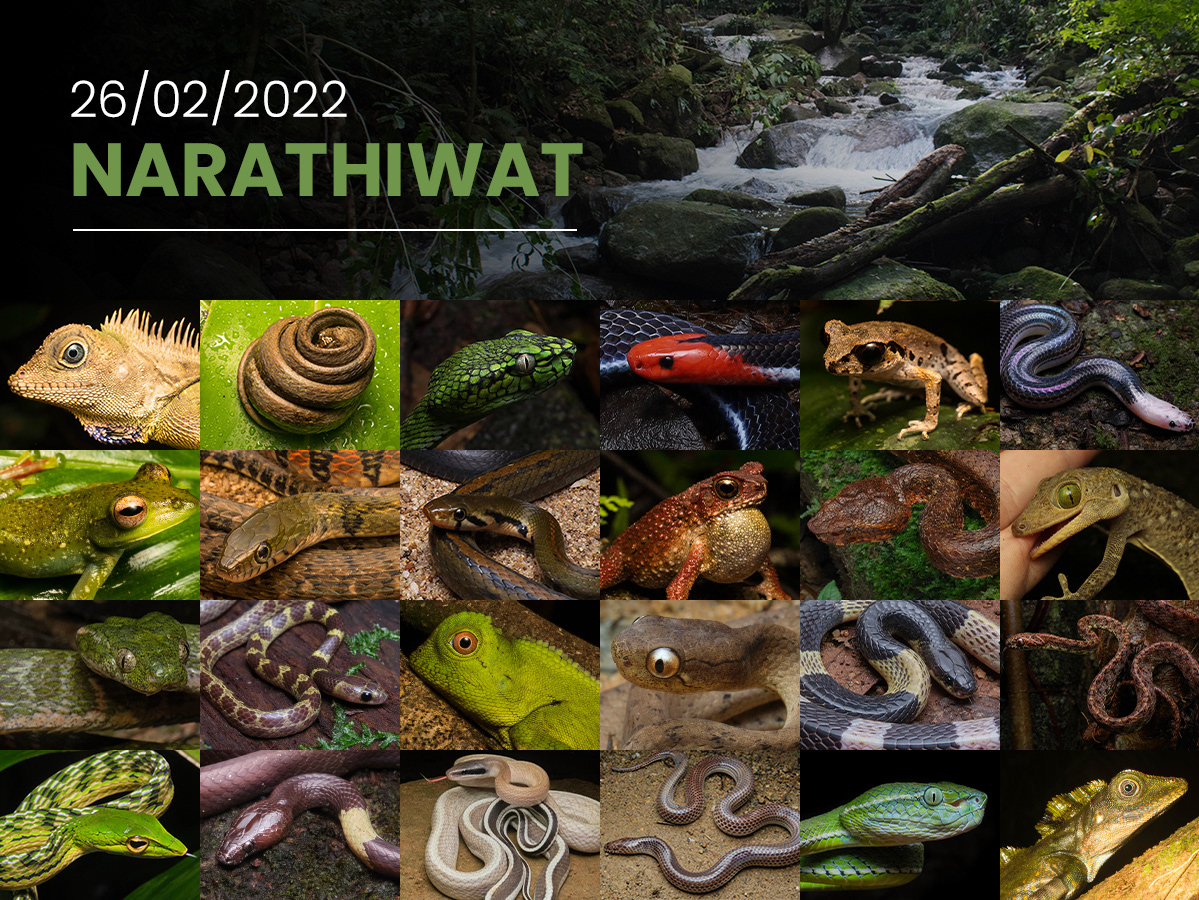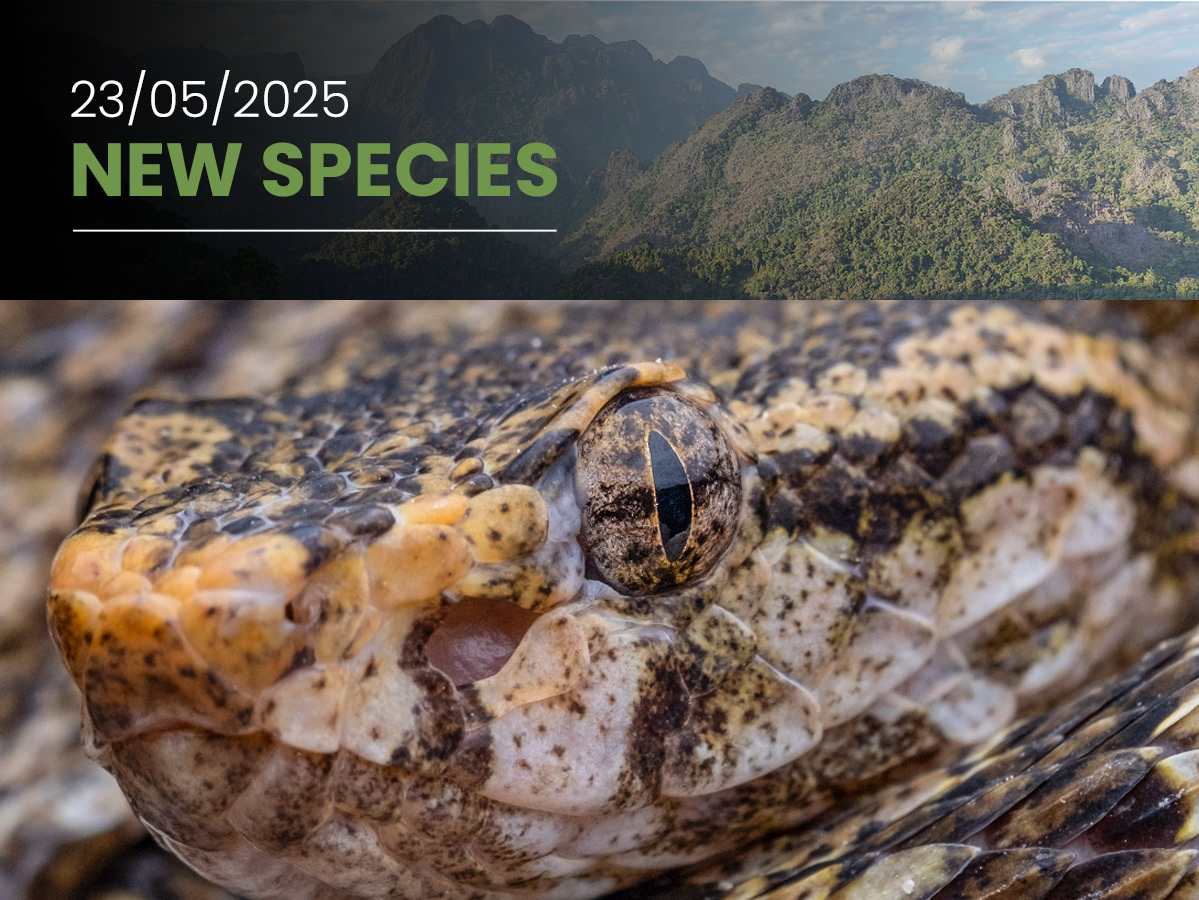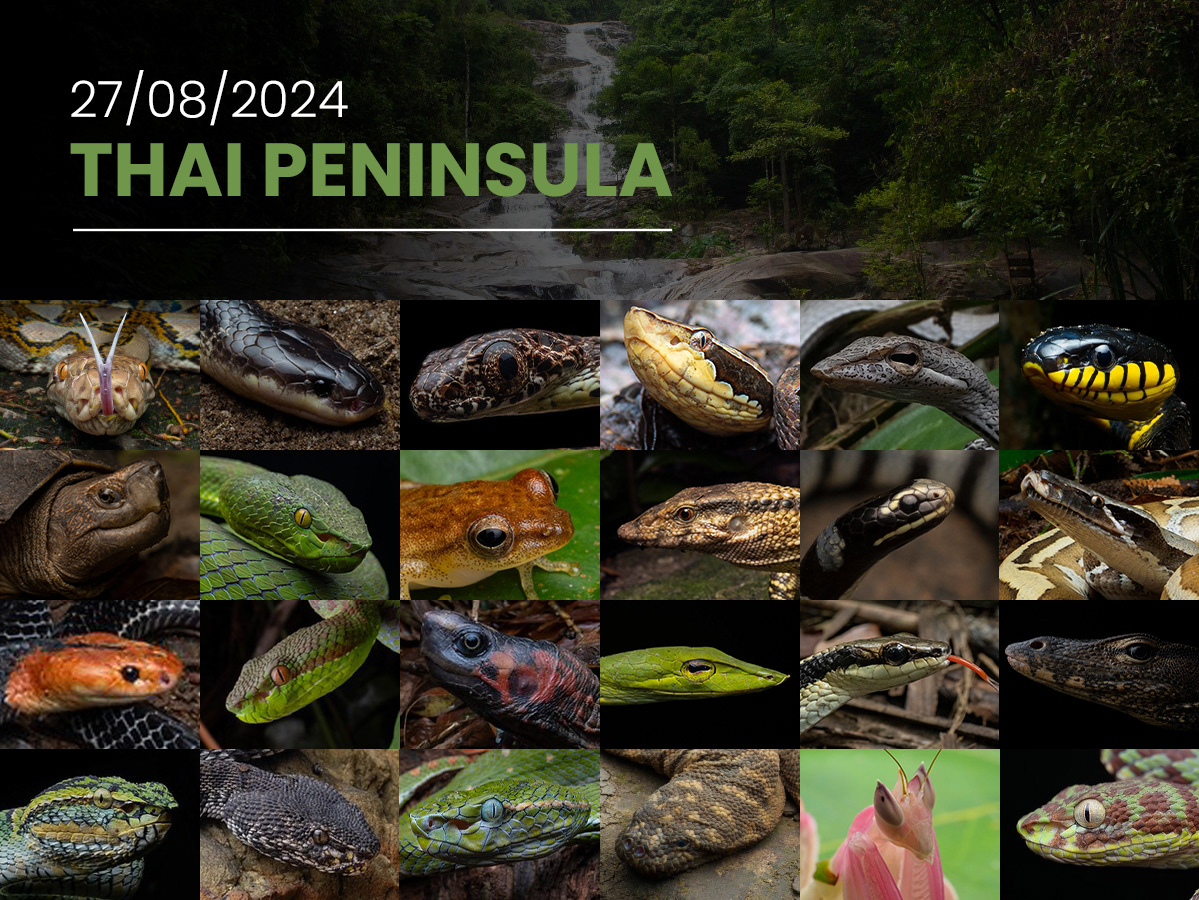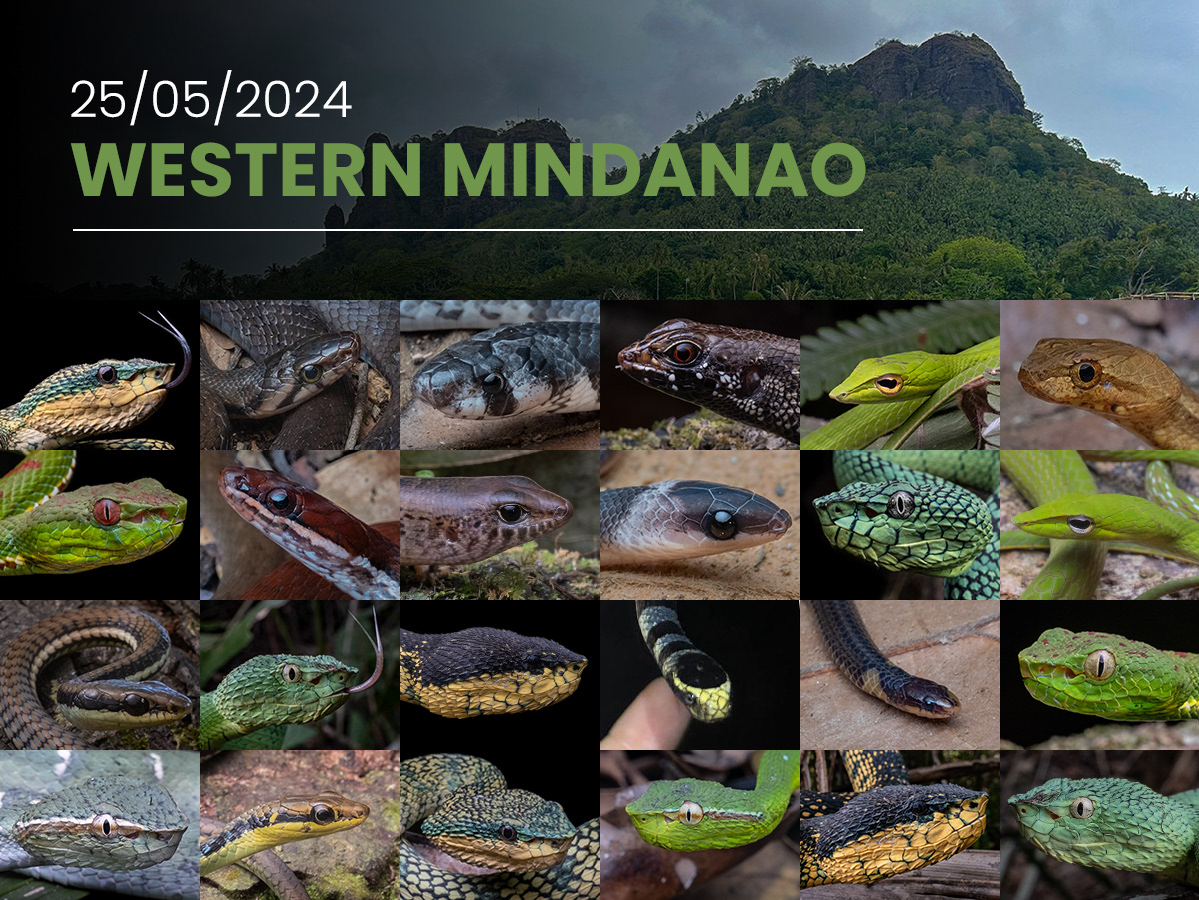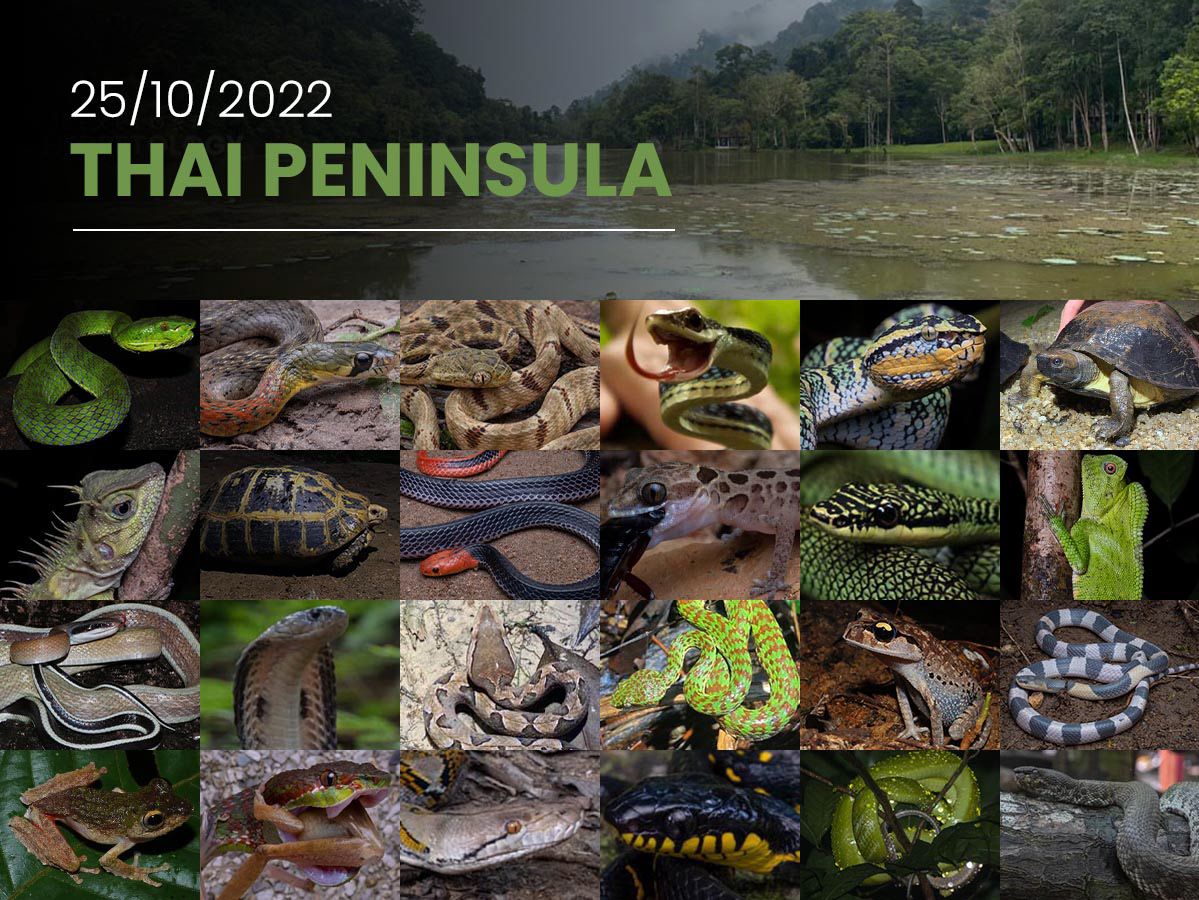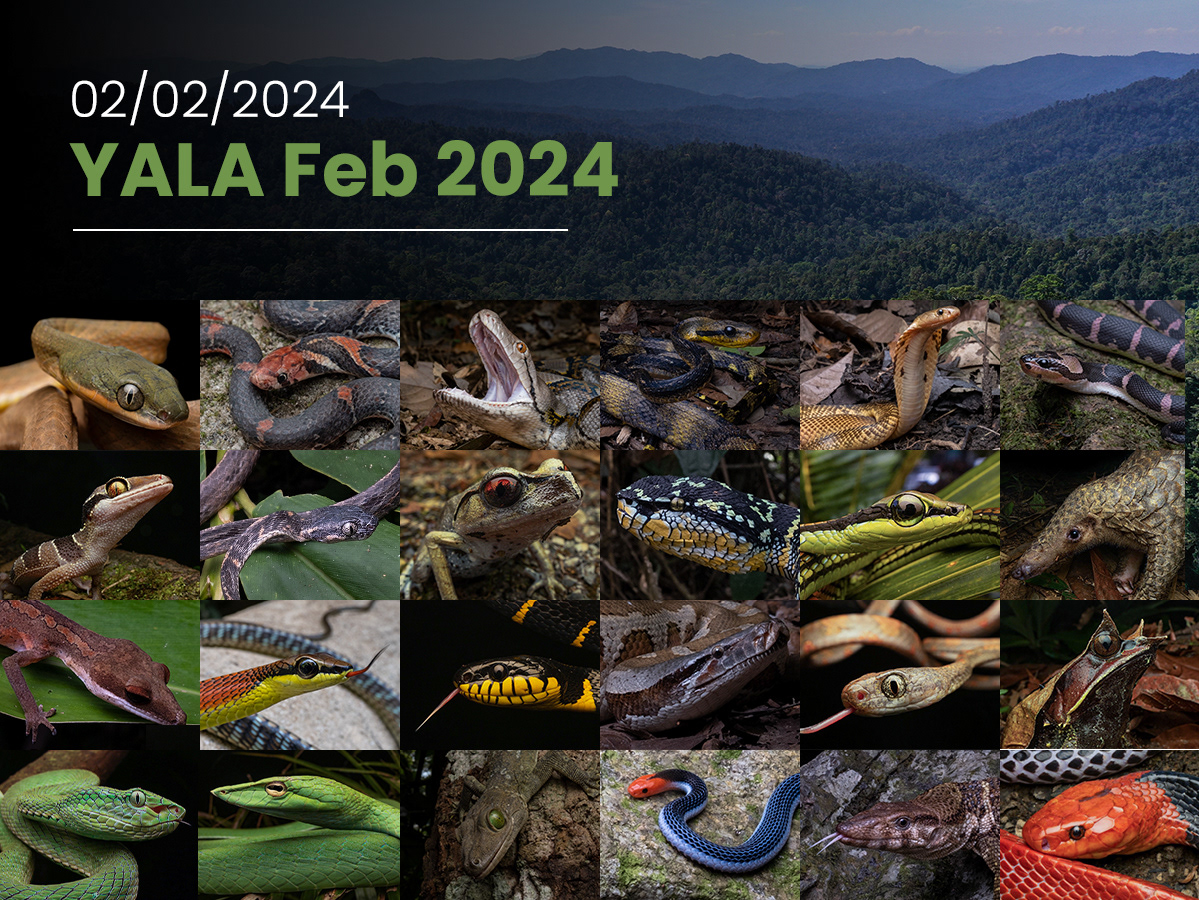Introduction
Led by legendary Malaysian nature guide Steven Wong, Explore Herpetology's first ever Expedition Malaysia began on the 7th March 2024 in Kuala Lumpur. We would spend 3 days at this location, before another 3 in the Cameron Highlands, ending with 4 days at Bukit Fraser. The aim was to encompass as much diversity as possible across all elevational ranges, while keeping travel between locations as brief as possible. The trip was fully booked with 8 guests and 3 Explore Herpetology staff members, spread across 3 vehicles. Similar to the previous year, 2024 had begun extremely dry and we only received rain on the first 2 days of the trip in Kuala Lumpur. Fortunately, in tropical South-East Asia, reptiles and amphibians are still very active during the dry periods and we ended up with a fantastic list, including many showstoppers and rarities. Want to join next year's expedition? BOOK HERE!
Kuala Lumpur
We began our first night in style by showing the guests a flawless red-headed krait (Bungarus flaviceps) which our team had caught the previous night by chance at a nearby stream. After that, we pushed up the trail and encountered another two species of snake, a mock viper (Psammodynastes pulverulentus) and a striped bronzeback (Dendrelaphis caudolineatus).
Our first location of the trip is one of the best places for frogs in South-East Asia, so we spent much of the following hours locating and photographing an incredible selection of amphibians. Most notably, we saw fantastic individuals of the "big three" lowlands Rhacophorus species; Wallace's flying frog (Rhacophorus nigropalmatus), Norhayati's flying frog (Rhacophorus norhayatii) and harlequin flying frog (Rhacophorus pardalis). Other remarkable amphibian encounters included many large and beautiful long-nosed horned frogs (Pelobatrachus nasuta), as well as a few dark-eared tree frogs (Polypedates macrotis) and a cinnamon frog (Nyctixalus pictus). Great angle-headed lizards (Gonocephalus grandis) and Bell's angle-headed lizards (Gonocephalus belli) were also abundant and evoked a lot of fascination. Only one more snake appeared that night, a dusky wolf snake (Lycodon albofuscus).
The following day, some pleasant cloudy weather allowed us to get out for a daytime hike at a local forest stream. A small pond had two triangle keelbacks (Xenochrophis trianguligerus) swimming around inside, of which we caught the larger individual. Also spotted during that walk was an earless agamid (Aphaniotis fusca) and a juvenile green crested lizard (Bronchocela cristatella).
That night, we visited coastal mangrove forest in the hopes of seeing both mangrove pit viper (Trimeresurus purpureomaculatus) and banded krait (Bungarus fasciatus). We saw around 10 mangrove pit vipers (Trimeresurus purpureomaculatus), including several very large adult females. Unfortunately, despite many rounds of the boardwalk, no banded kraits made an appearance this time. We switched things up with some road cruising and turned up the world's fattest sunbeam snake (Xenopeltis unicolor), followed shortly by a large reticulated python (Malayopython reticulatus).
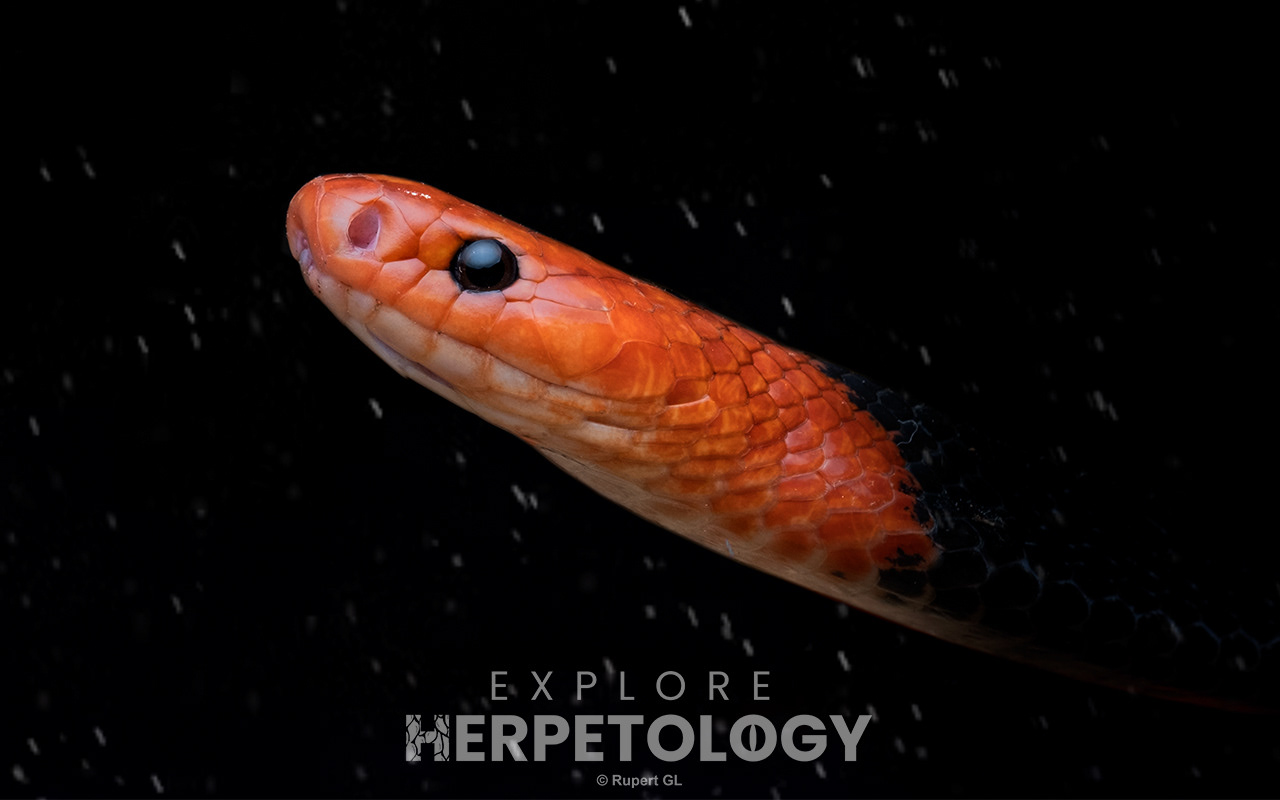
Red-headed krait (Bungarus flaviceps)
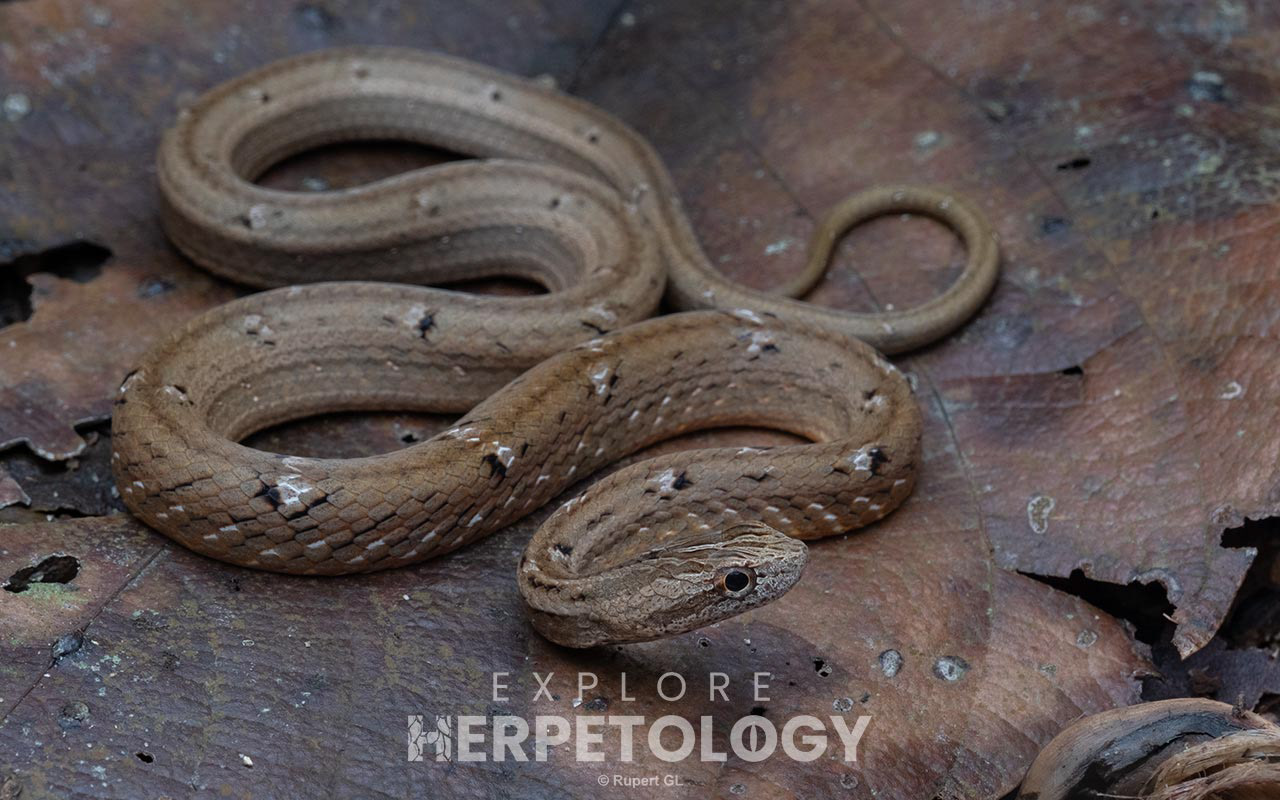
Mock viper (Psammodynastes pulverulentus)

Striped bronzeback (Dendrelaphis caudolineatus)

Long-nosed horned frog (Pelobatrachus nasuta)

Harlequin flying frog (Rhacophorus pardalis)
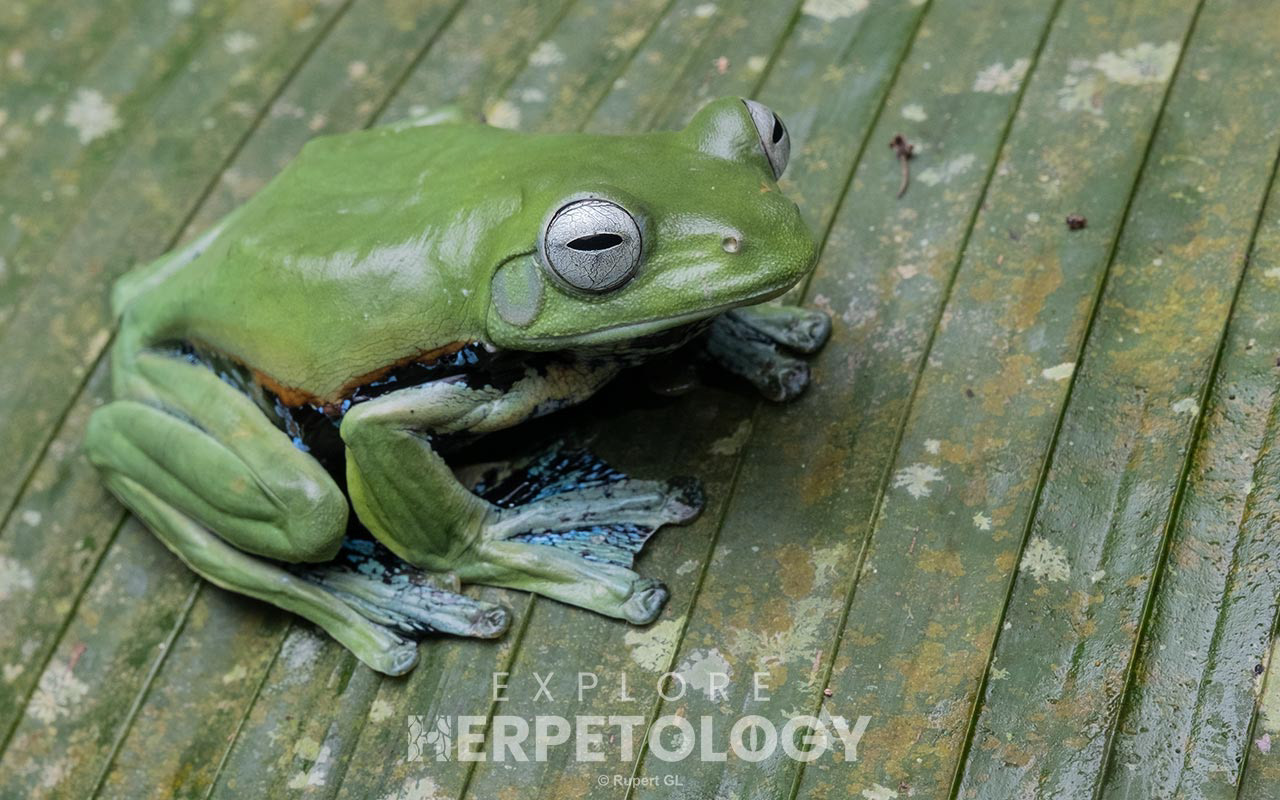
Norhayati's flying frog (Rhacophorus norhayatii)
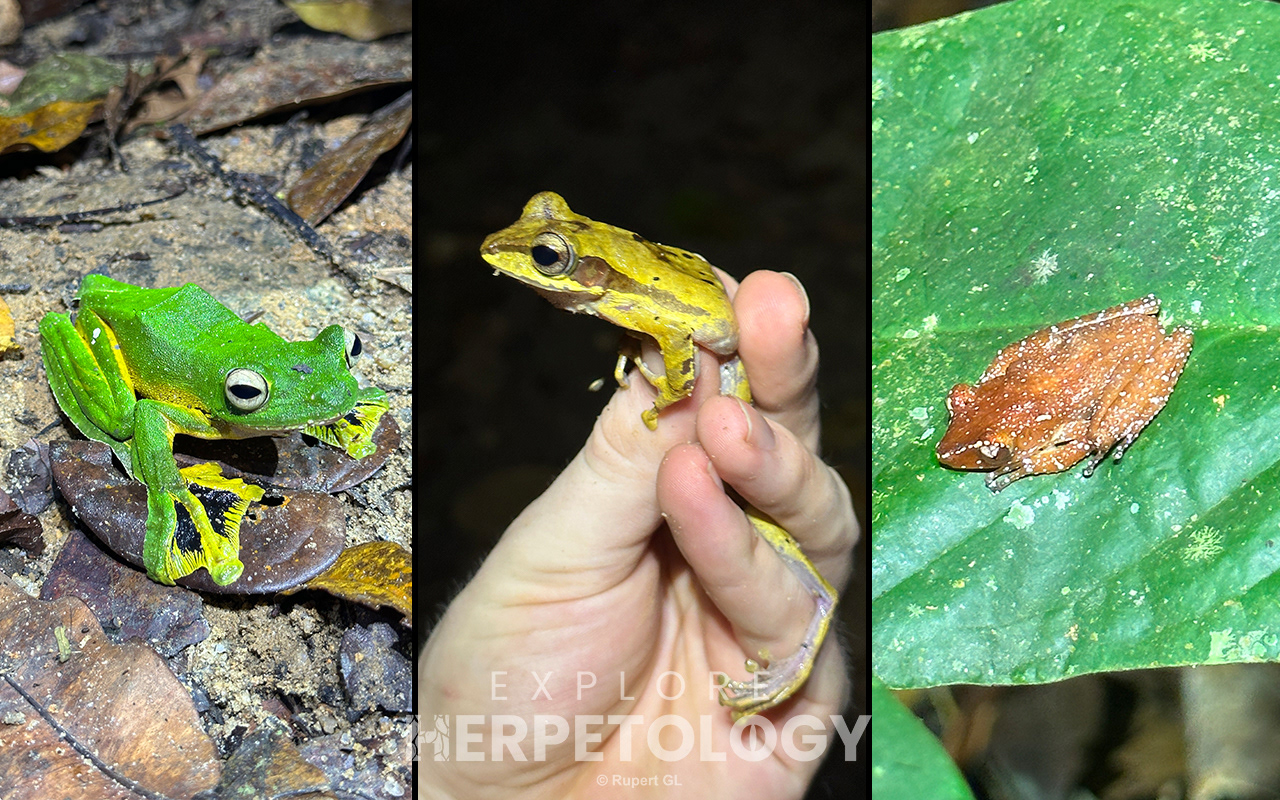
Left to right: Rhacophorus nigropalmatus, Polypedates macrotis, Nyctixalus pictus

Left: Lycodon albofuscus. Right: Gonocephalus belli
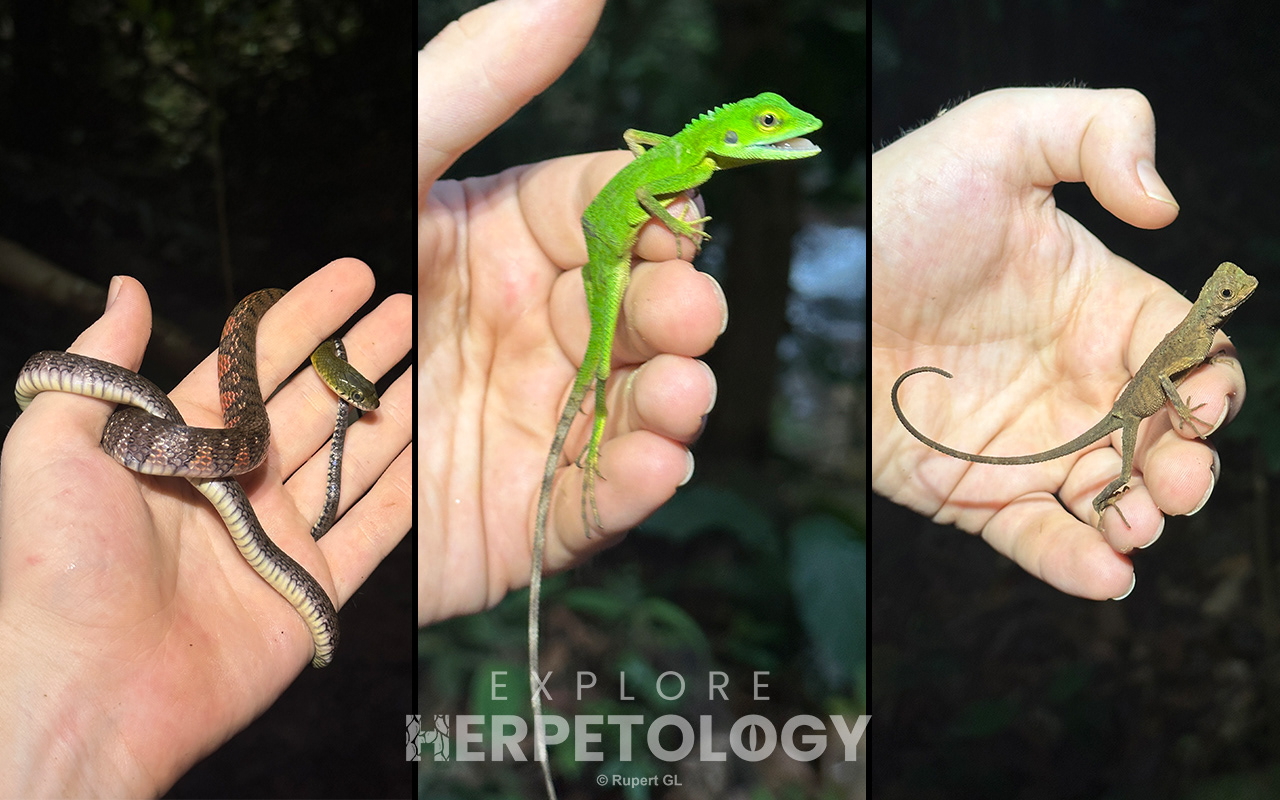
Left to right: Xenochrophis trianguligerus, Bronchocela cristatella, Aphaniotis fusca

Sunbeam snake (Xenopeltis unicolor)
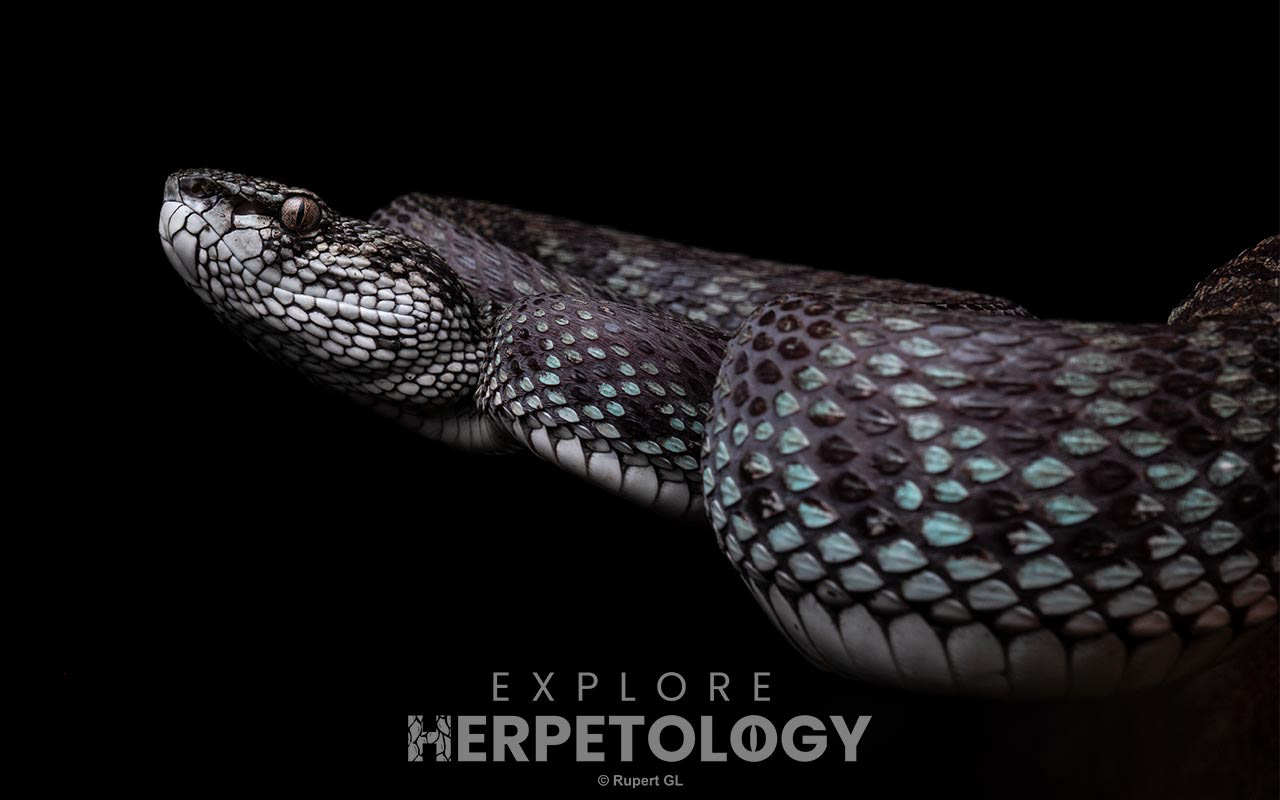
Mangrove pit viper (Trimeresurus purpureomaculatus)
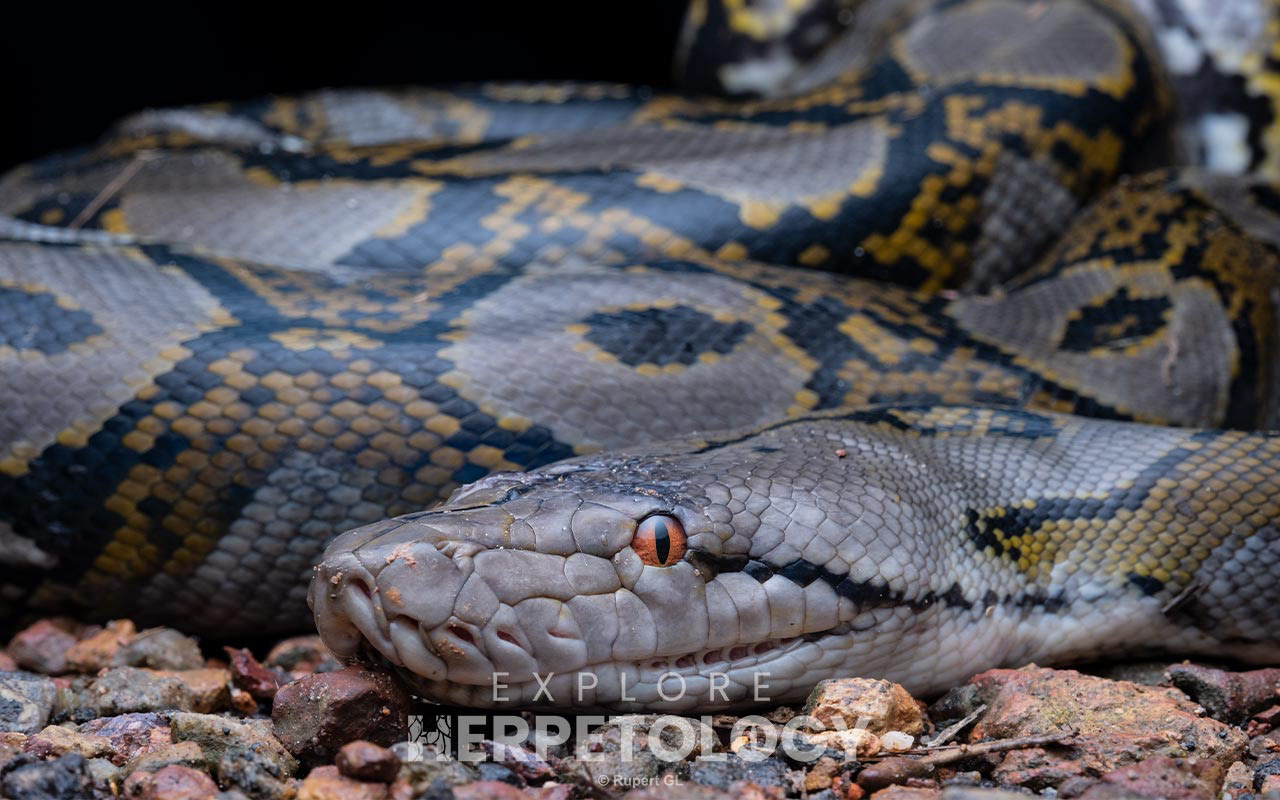
Reticulated python (Malayopython reticulatus)
On our final day in KL, it was too hot and sunny to get out on foot to search for snakes in the daytime, so we rested up and got out at night for a full night of lowland forest herping. We turned up many species of snake on this evening, including several painted bronzebacks (Dendrelaphis pictus), a blue bronzeback (Dendrelaphis cyanochloris), Malayan vine snake (Ahaetulla mycterizans) and another striped bronzeback (Dendrelaphis caudolineatus. The highlights of the evening were a large (2 meter) keeled rat snake (Ptyas carinata) that was sleeping in some low bushes and a juvenile red-tailed racer (Gonyosoma oxycephalum). We also saw a male Wagler's pit viper (Tropidolaemus wagleri) and many of the same frogs and lizards as the night before. Some members of our group caught a water monitor (Varanus salvator), but it escaped before the rest could see it.
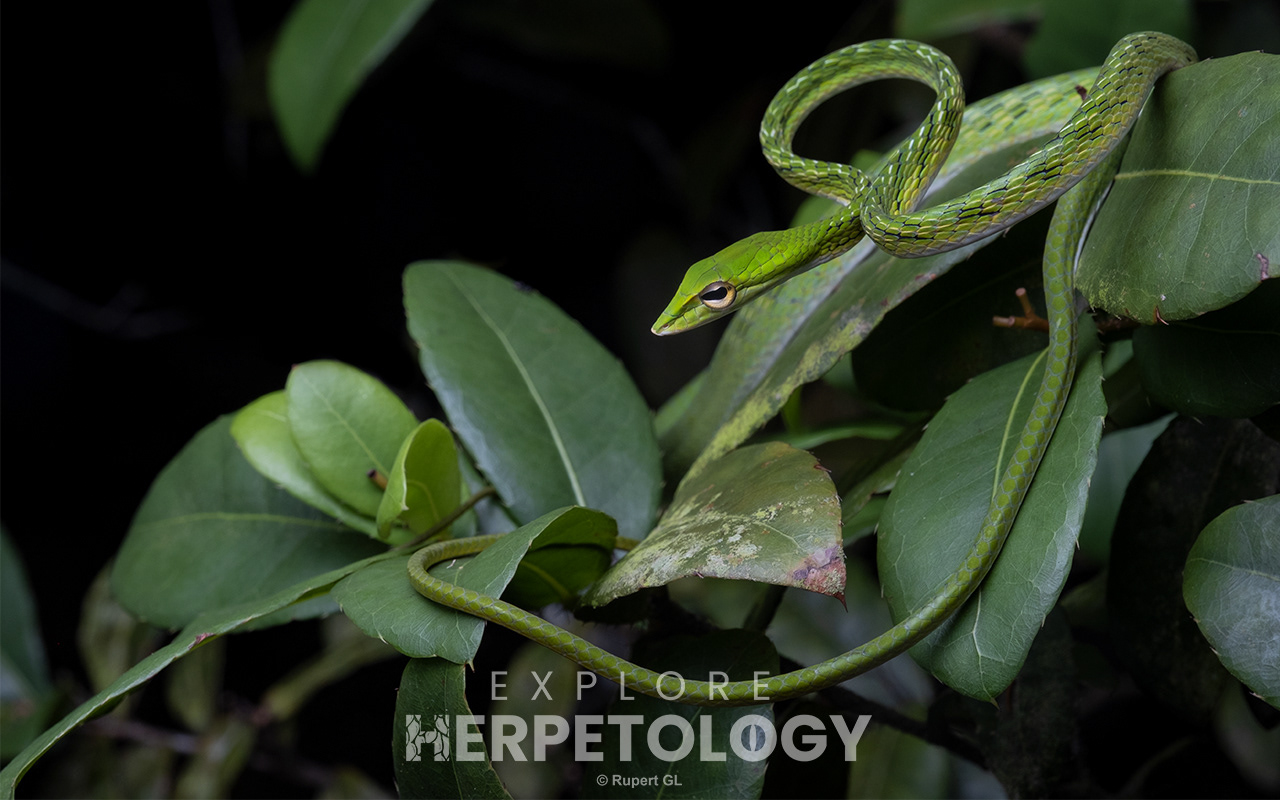
Malayan vine snake (Ahaetulla mycterizans)
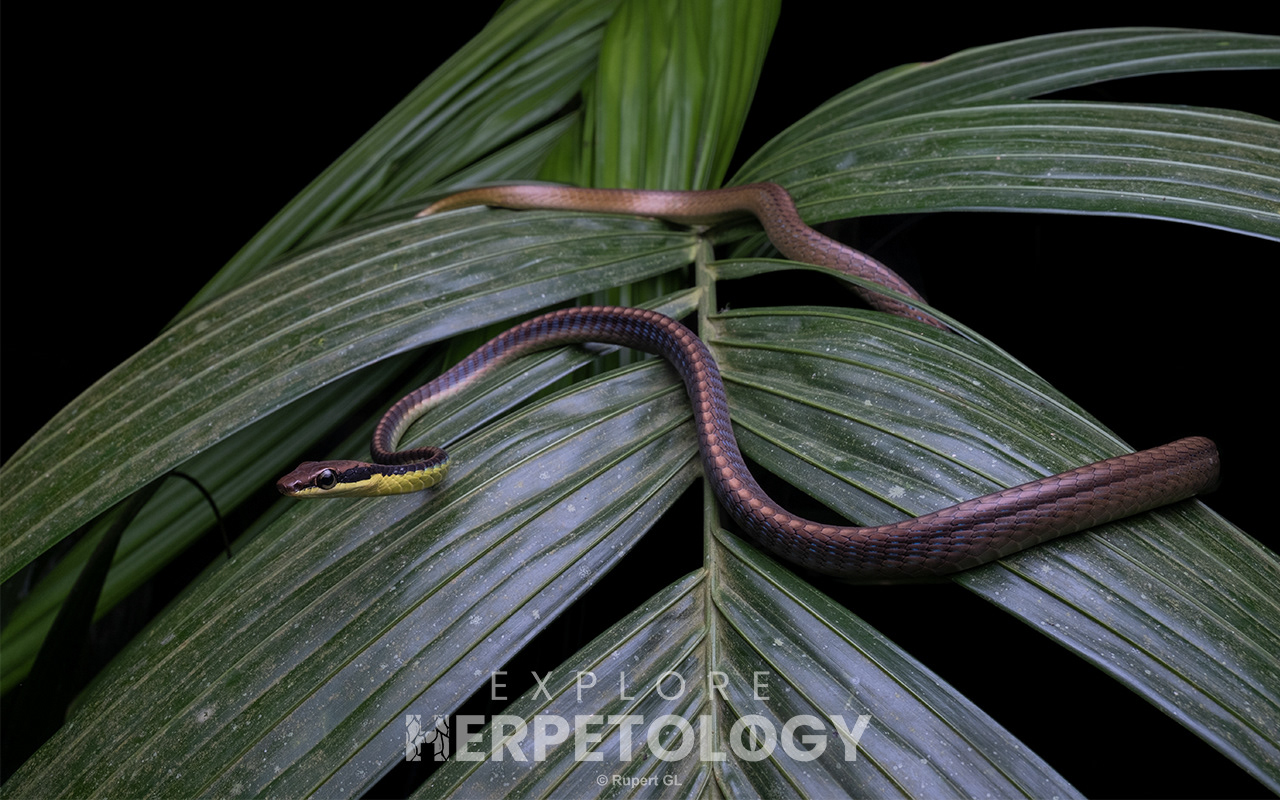
Blue bronzeback (Dendrelaphis cyanochloris)
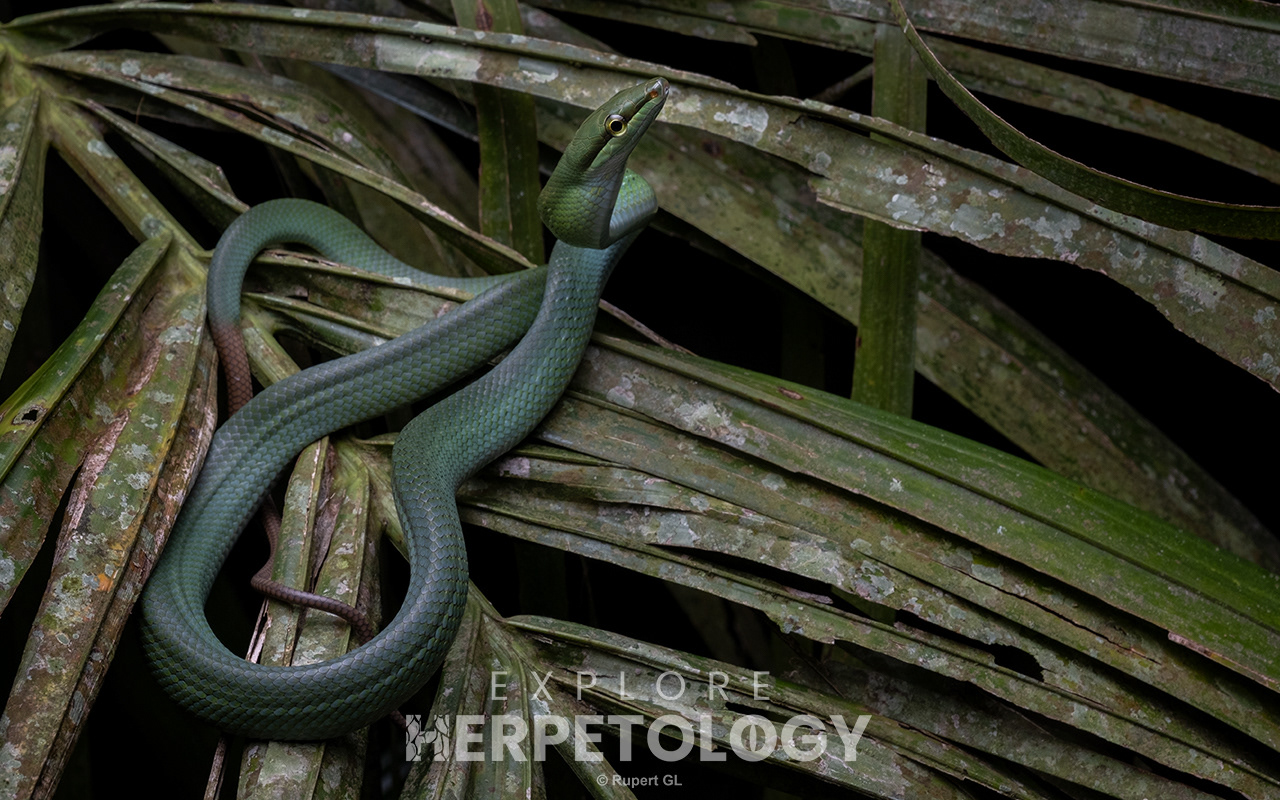
Red-tailed racer (Gonyosoma oxycephalum)

Keeled rat snake (Ptyas carinata)
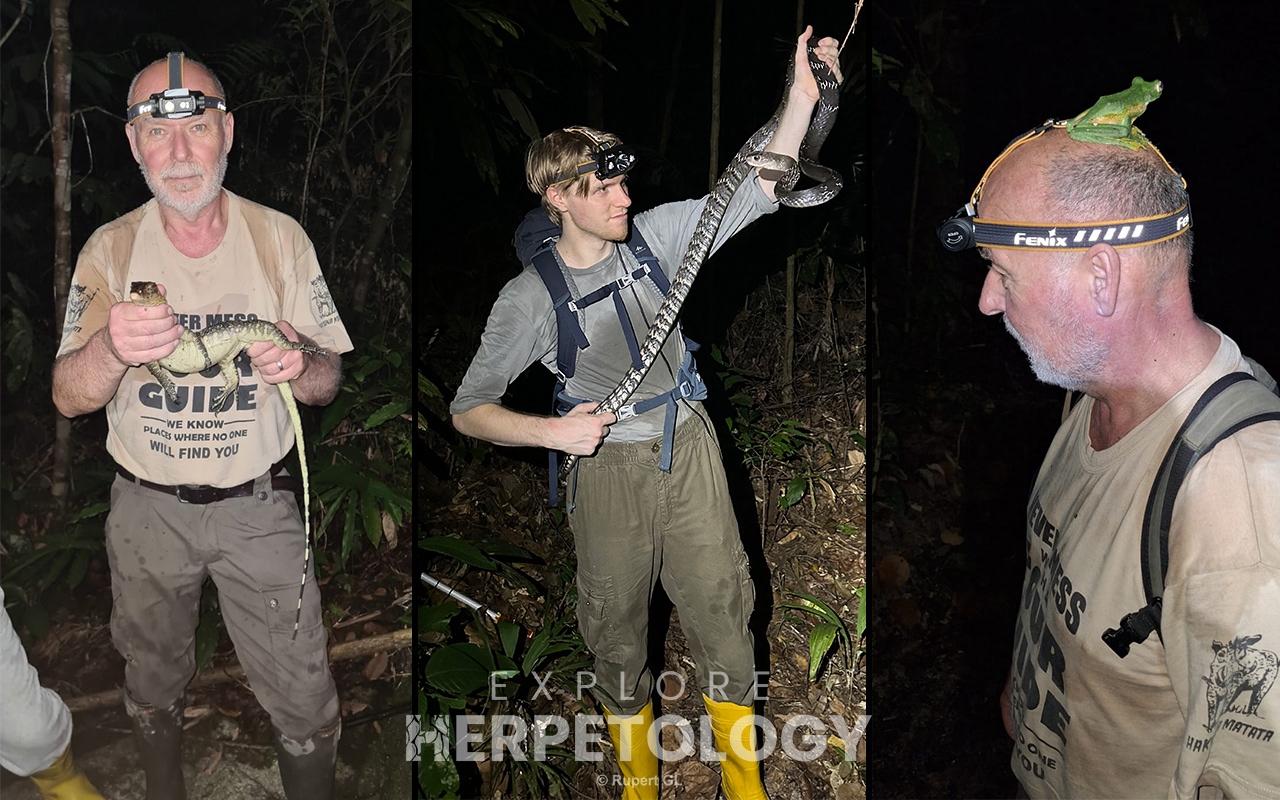
Varanus salvator, Ptyas carinata and Rhacophorus nigropalmatus
Cameron Highlands
After a productive start to the trip numbers-wise, we left the heat and humidity of Kuala Lumpur and drove a few hours to the Cameron Highlands. Despite being one of the most popular tourist destinations in Malaysia, beyond the tea plantations are swathes of upper-submontane forest home to many remarkable montane endemics. This area is also notoriously difficult when it comes to turning up snakes, so we set expectations to reasonable levels.
The first night rapidly exceeded expectations with many snakes showing up from the first few minutes of hiking. We saw multiple Schulz's reed snakes (Macrocalamus schulzi), along with some golden-bellied reed snakes (Macrocalamus emas) and a young Tweedie's reed snake (Macrocalamus tweediei). We also encountered multiple of the awesome mirkwood forest slug snakes (Asthenodipsas lasgalenensis). Some uncommon species appeared, with two Malayan mountain keelbacks (Hebius inas) and a Butler's wolf snake (Lycodon butleri). We also saw several Malayan mountain dragons (Malayodracon robinsonii) and caught one of the uncommon agamid lizards in the area, a yellow-throated false bloodsucker (Pseudocalotes flavigula). A sad lizard encounter was a DOR three-banded supple skink (Larutia trifasciata), a very rare and coveted montane endemic.

Schulz's reed snake (Macrocalamus schulzi)

Tweedie's reed snake (Macrocalamus tweediei)
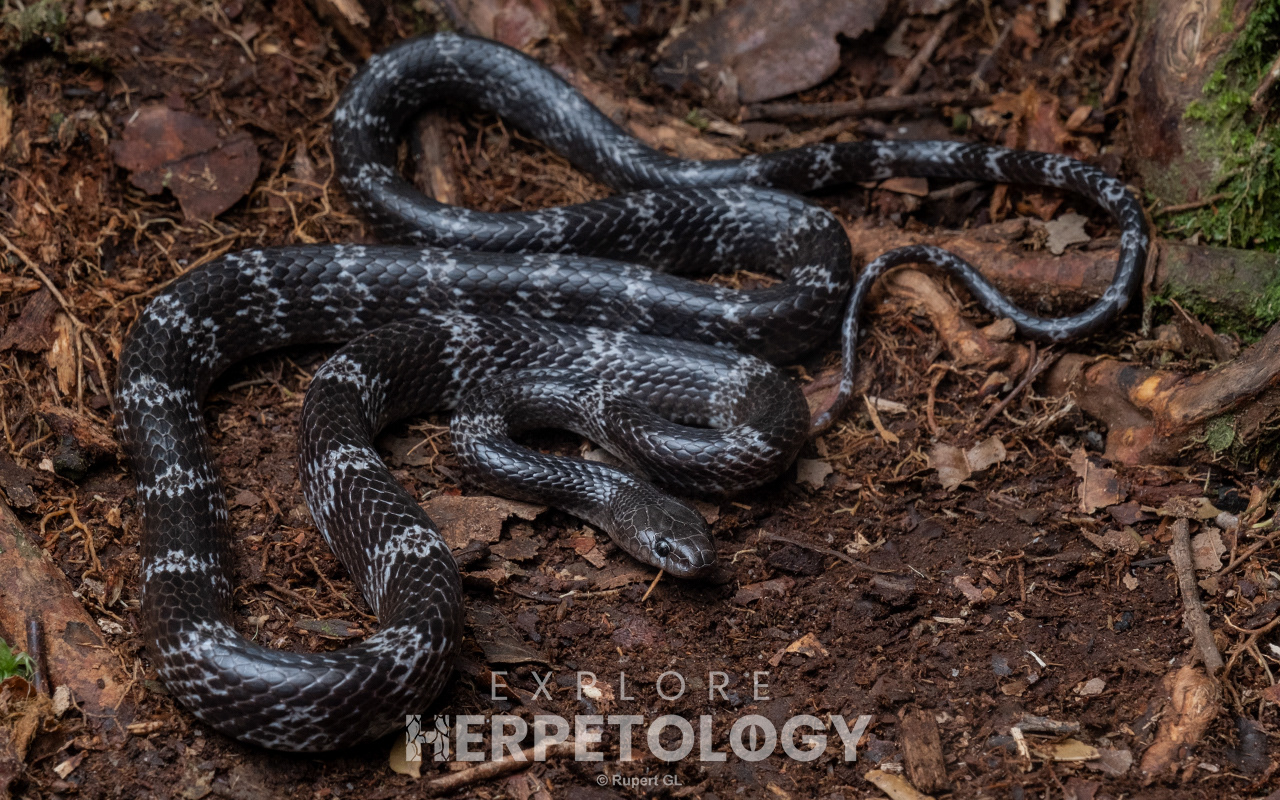
Butler's wolf snake (Lycodon butleri)

Three-banded supple skink (Larutia trifasciata)
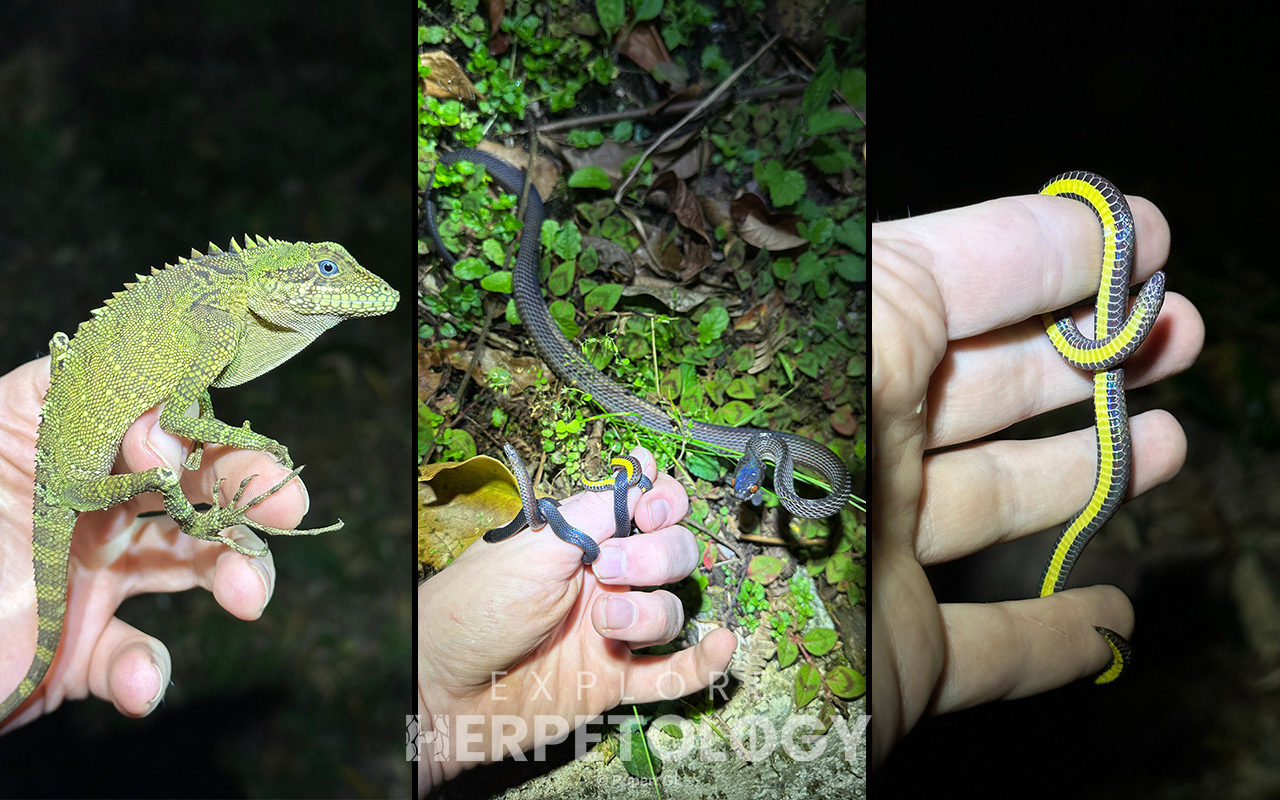
Left to right: Malayodracon robinsonii, snake party, ventral of Macrocalamus emas

Yellow-throated false bloodsucker (Pseudocalotes flavigula)

Malayan mountain keelback (Hebius inas)
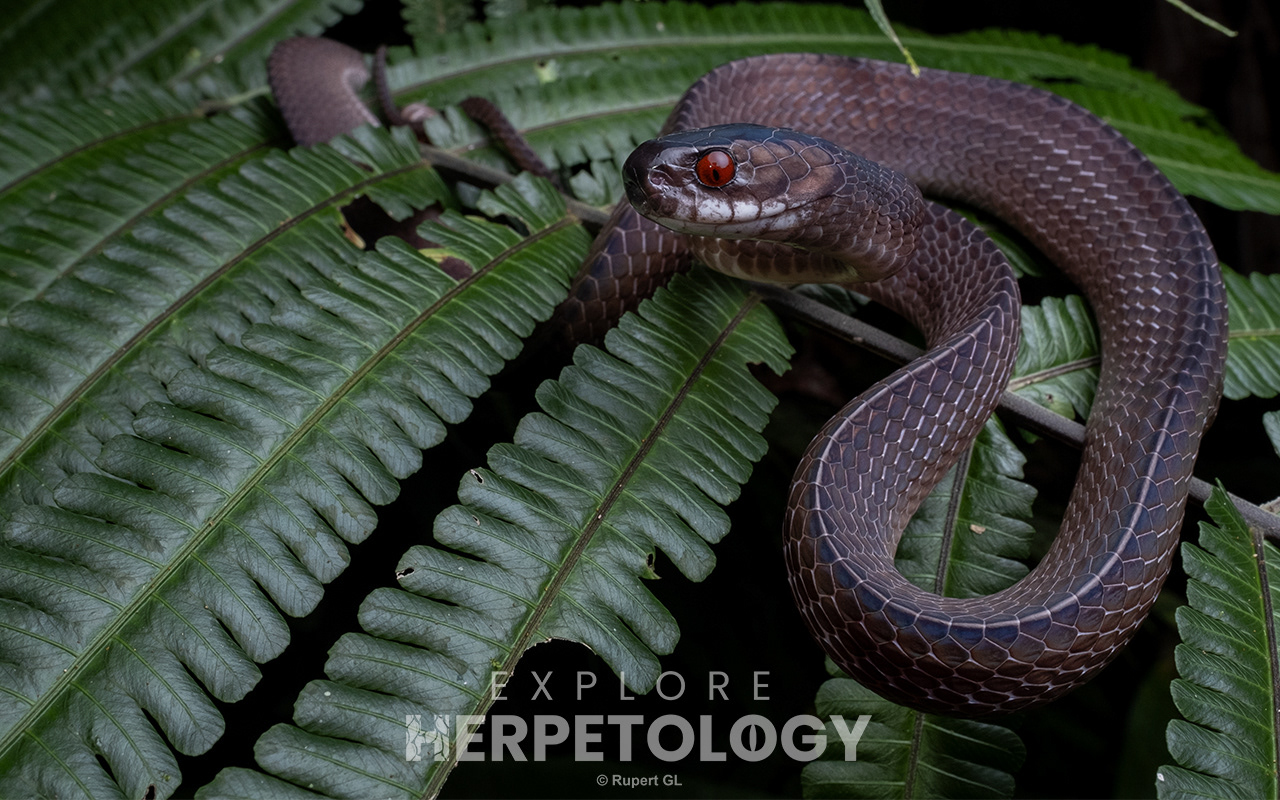
Mirkwood forest slug snake (Asthenodipsas lasgalenensis)
Our second day was mostly spent with photography and relaxing, although we did take a late afternoon walk which only turned up a couple fresh DORs. Come nightfall, we ran a similar agenda as the previous night and had similar success, with many different Macrocalamus sp. reed snakes and the usual slug snakes showing up, as well as more Malayan mountain keelbacks (Hebius inas) and a Schlegel's reed snake (Calamaria schlegeli) - a new species for the trip.
We had great success with lizards this evening, finding a huge adult Malayan mountain dragon (Malayodracon robinsonii), the uncommon Rhaegal's false bloodsucker (Pseudocalotes rhaegal) and a massive gravid female of the rare Titiwangsa horned lizard (Acanthosaura titiwangsaensis). The best was saved for last though, with arguably our group's biggest target for the area - the incredible red bamboo ratsnake (Oreocryptophis porphyracea laticinctus).
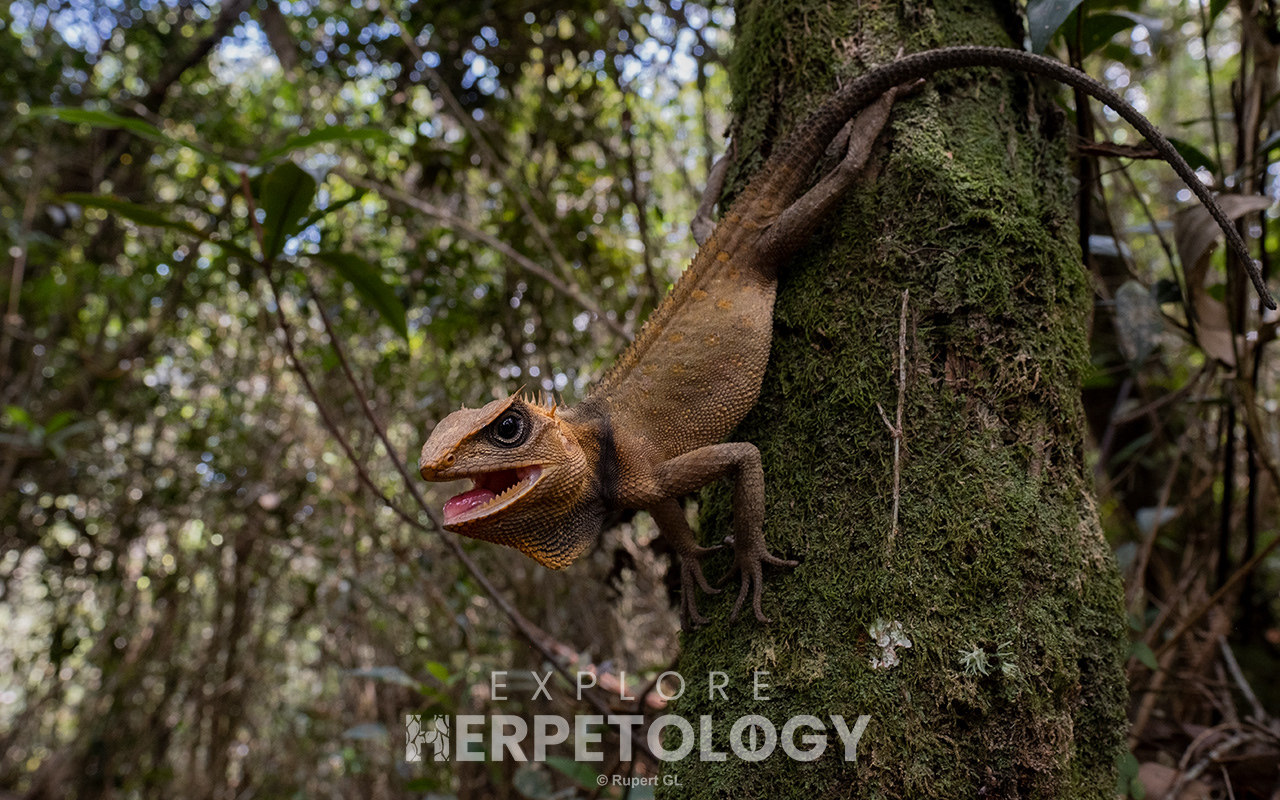
Titiwangsa horned lizard (Acanthosaura titiwangsaensis)
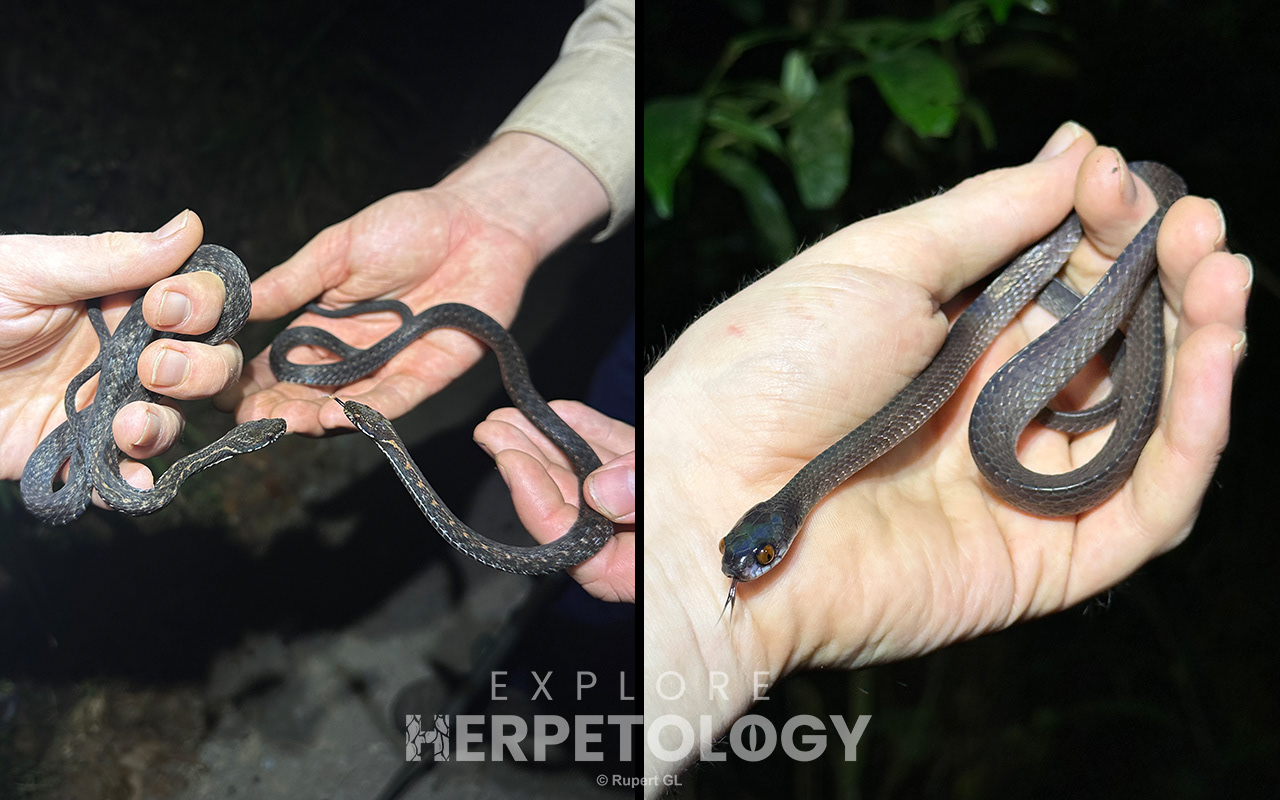
Left: Hebius inas. Right: Asthenodipsas lasgalenensis.
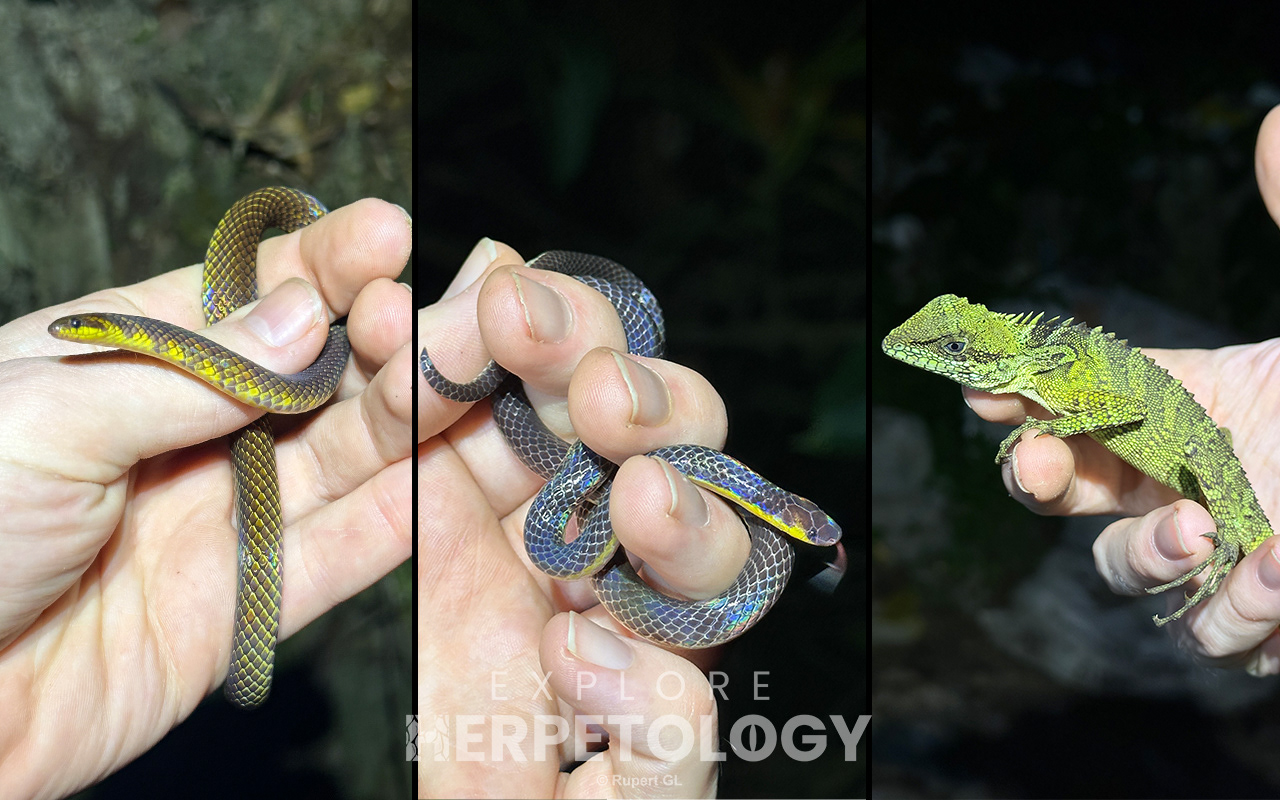
Left to right: Macrocalamus schulzi, Calamaria schlegeli, Malayodracon robinsonii.

Malayan mountain dragon (Malayodracon robinsonii)
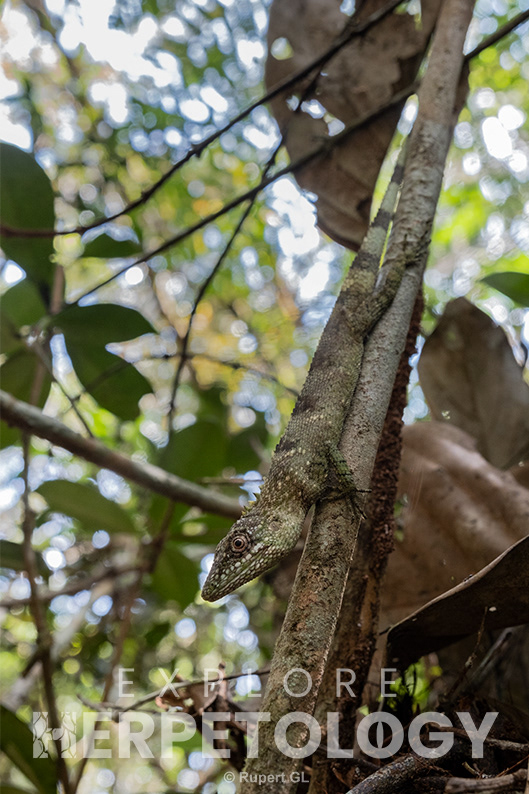
Rhaegal's false bloodsucker (Pseudocalotes rhaegal)

Red bamboo ratsnake (Oreocryptophis porphyracea)
For our final day in the Cameron Highlands, we visited some of the touristic sights and coincidentally turned up a diurnally active Schulz's reed snake (Macrocalamus schulzi). The numbers of this species active during this trip were truly remarkable. Usually Macrocalamus schulzi is the least commonly seen species of Macrocalamus in this area, but they were truly everywhere this trip. We saw at least 3 every single night.
Conversely, the usually ubiquitous Cameron Highlands pit viper (Trimeresurus nebularis) had be utterly absent. We had seen one single individual up to this point, but it was high up in a tree and disappeared in a matter of seconds. Things were getting desperate at this point, so we decided to dedicate our final night to turning up one of these. With all the kilometres covered over the last 2 nights, it felt unlikely that walking the same areas would change our fortunes. However, on one of the short riparian trails we had walked both nights prior, there was a lovely little female Trimeresurus nebularis sitting in ambush in the most obvious location.
After finding our biggest target for the night, we switched things up to target the black-striped coral snake (Calliophis nigrotaeniatus), but unfortunately only saw a fresh DOR individual. While searching for this, Rupert caught a small purple kukri snake (Oligodon purpurascens) which was hiding inside a pipe, along with many other repeat species from the last two nights. Digging in leaf litter, Plato turned up a very rare species to end our trip, Williamson's reed snake (Collorhabdion williamsoni) - what we call a 'turbo-rare megalifer' around here!
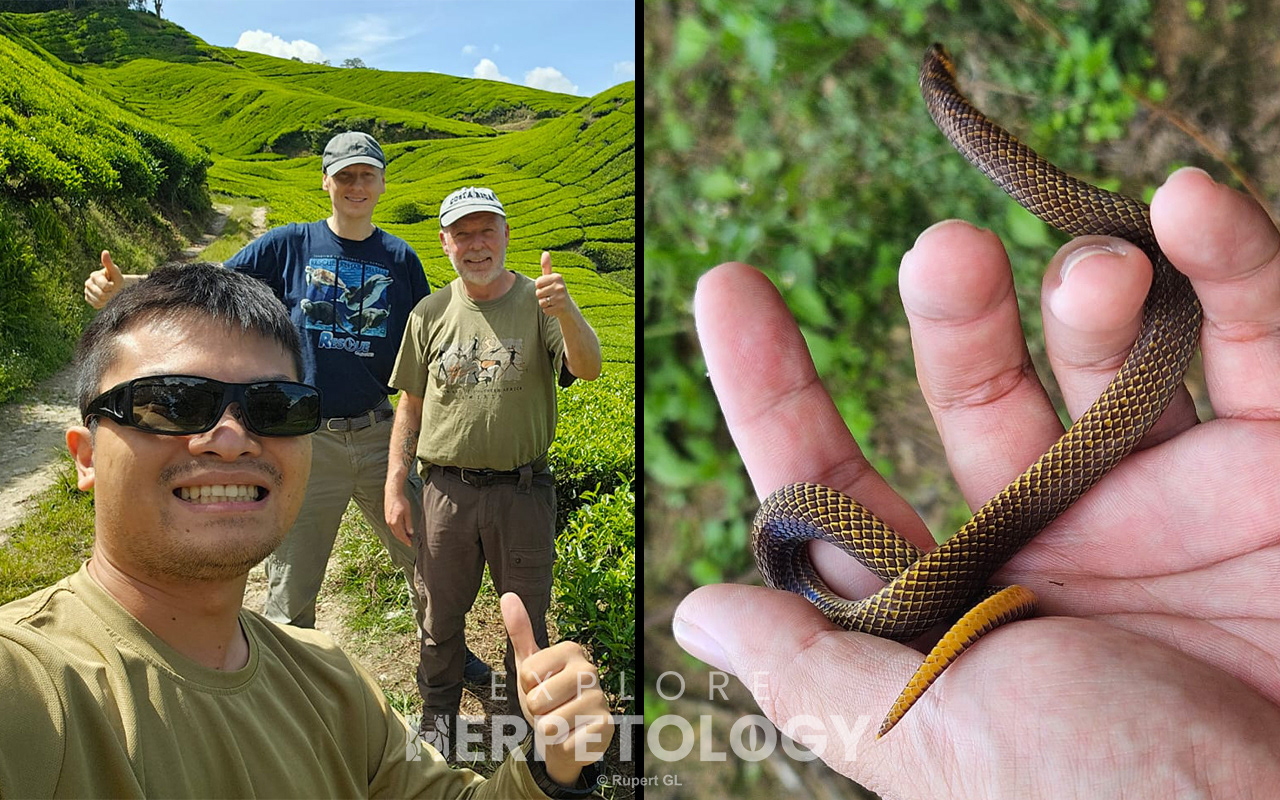
Daytime shenanigans

Williamson's reed snake (Collorhabdion williamsoni)
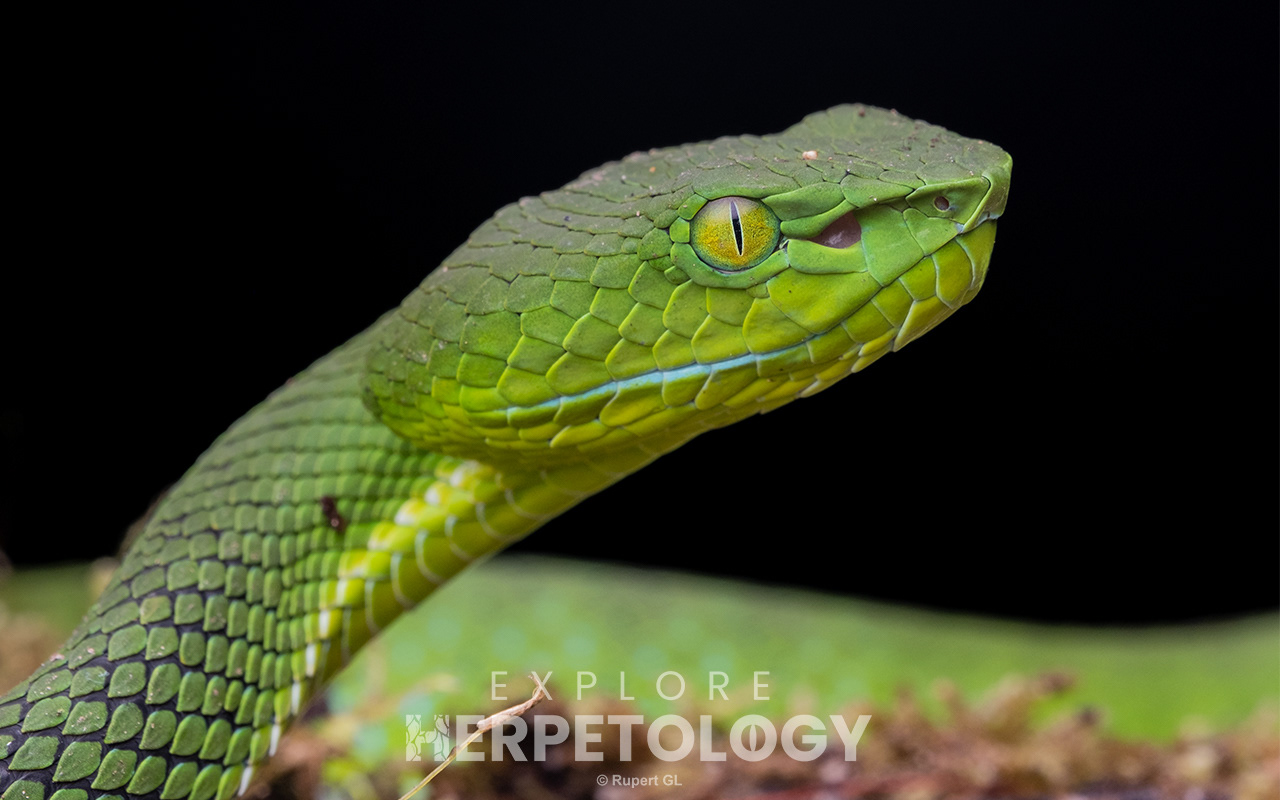
Cameron Highlands pit viper (Trimeresurus nebularis)

Cameron Highlands pit viper (Trimeresurus nebularis)
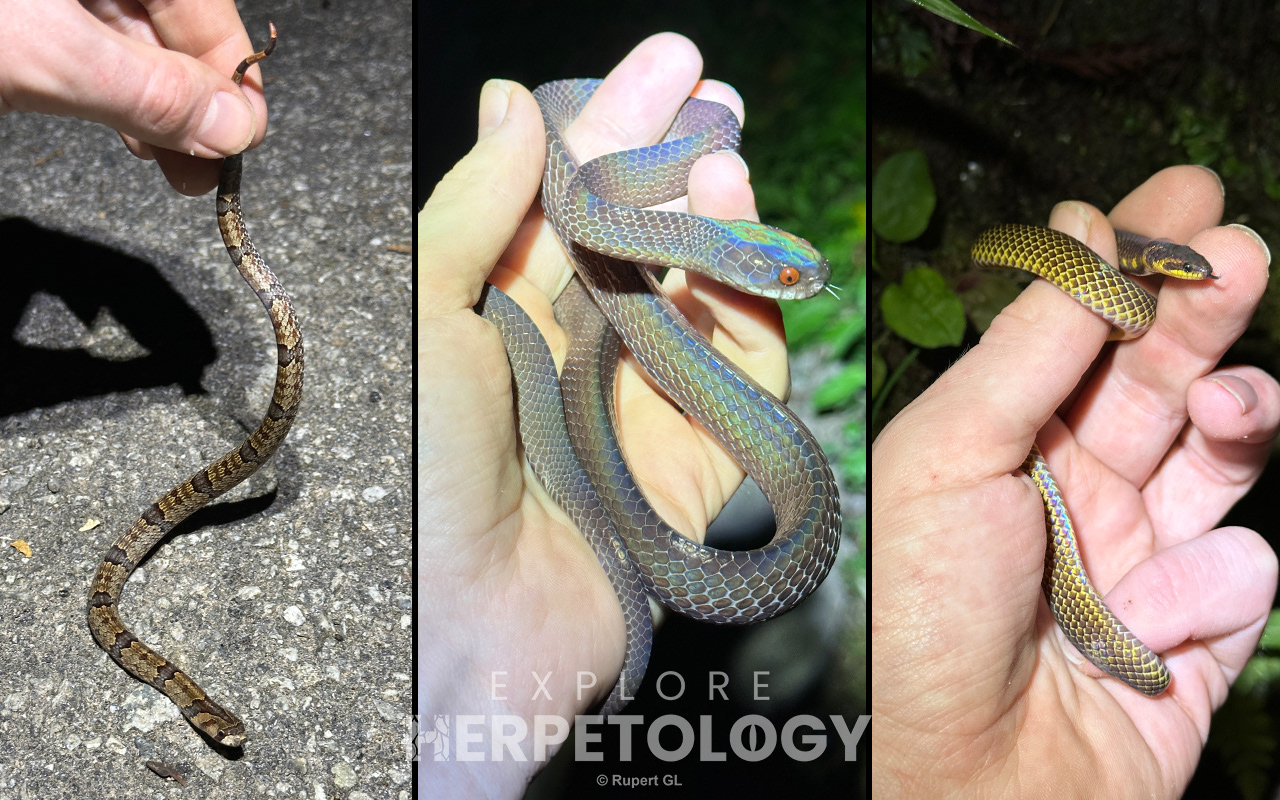
Left to right: Oligodon purpurascens, Asthenodipsas lasgalenensis, Macrocalamus schulzi
Bukit Fraser
After an extremely enjoyable 3 days in the Cameron Highlands, we moved on just a little further south and lower in elevation to Bukit Fraser, a quiet hill station with unbridled access to fantastic highland rainforest. Being at lower elevation, you see far more non-montane endemic species in this area, but still have a lot of high-elevation biodiversity to boot. This makes the area an extremely appetising prospect for herping, hence why we scheduled 4 nights at this specific location.
Night one could not have gone better, as just a couple hours into the evening our guests Jake and Jordan found a huge and stunningly beautiful blue coral snake (Calliophis bivirgata), one of our biggest targets for the area. We also encountered multiple Sabah pit viper (Trimeresurus sabahi fucatus) - not hiding away like the Cameron Highlands pit viper was - and another species of coral snake, the small yet lovely Malayan banded coral snake (Calliophis intestinalis). Our first oriental vine snake (Ahaetulla prasina) and Chan-ard's reed snake (Macrocalamus chanardi) of the trip made an appearance too.

Left: Sphenomorphis praesignis. Right: Ahaetulla prasina
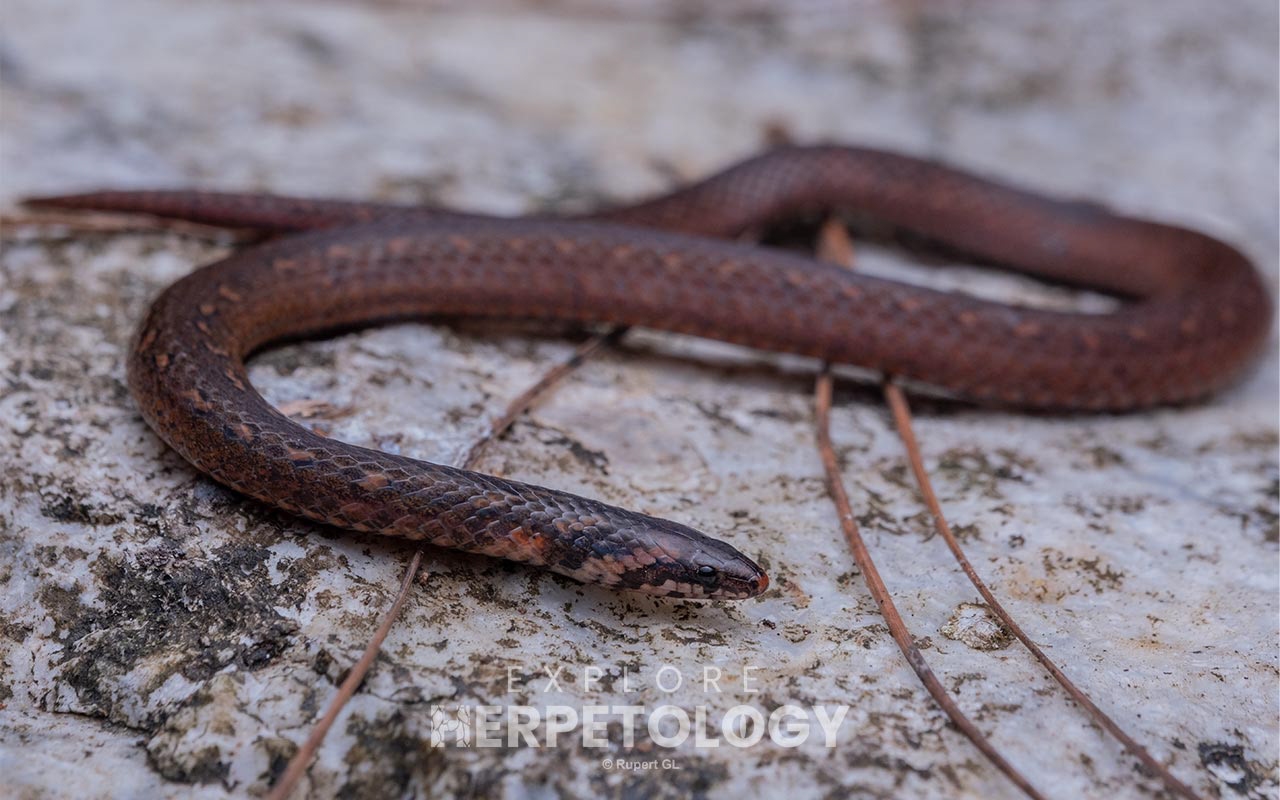
Chan-ard's reed snake (Macrocalamus chanardi)

Sabah pit viper (Trimeresurus sabahi fucatus)
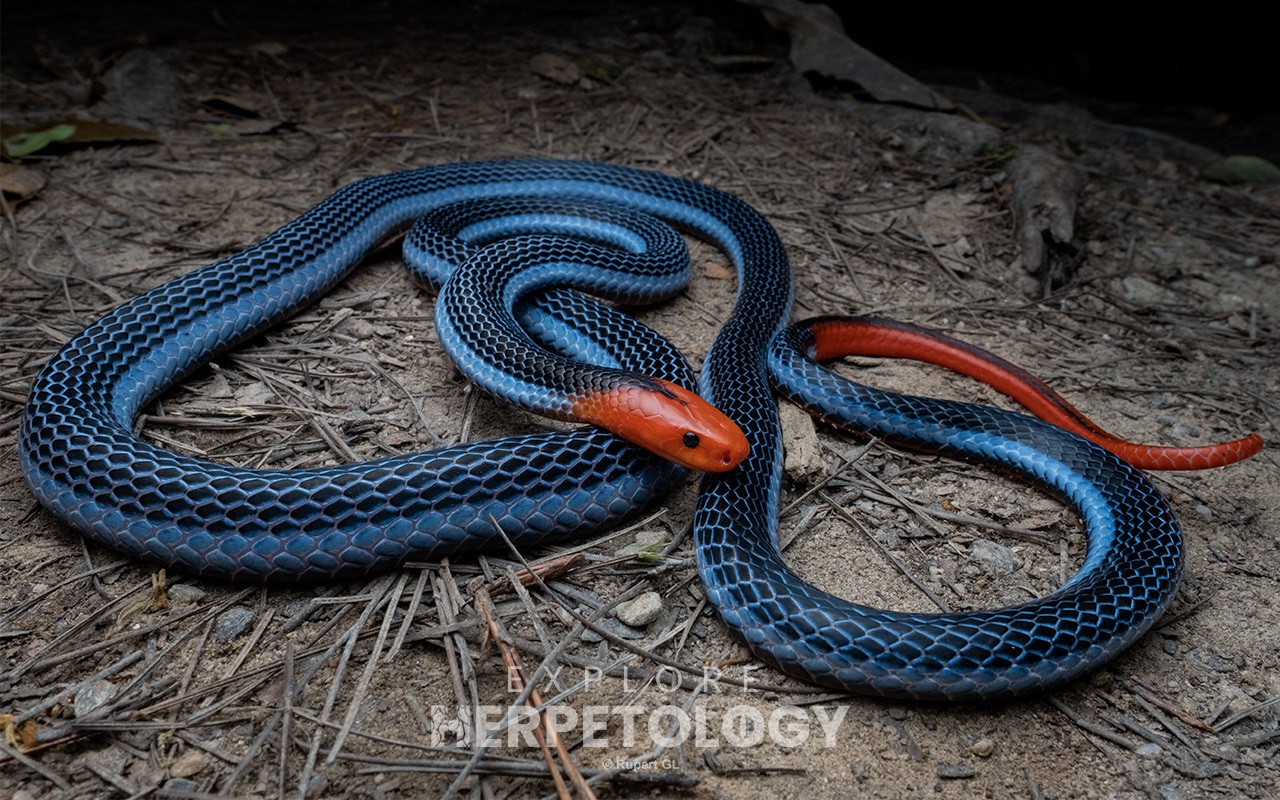
Blue coral snake (Calliophis bivirgata flaviceps)
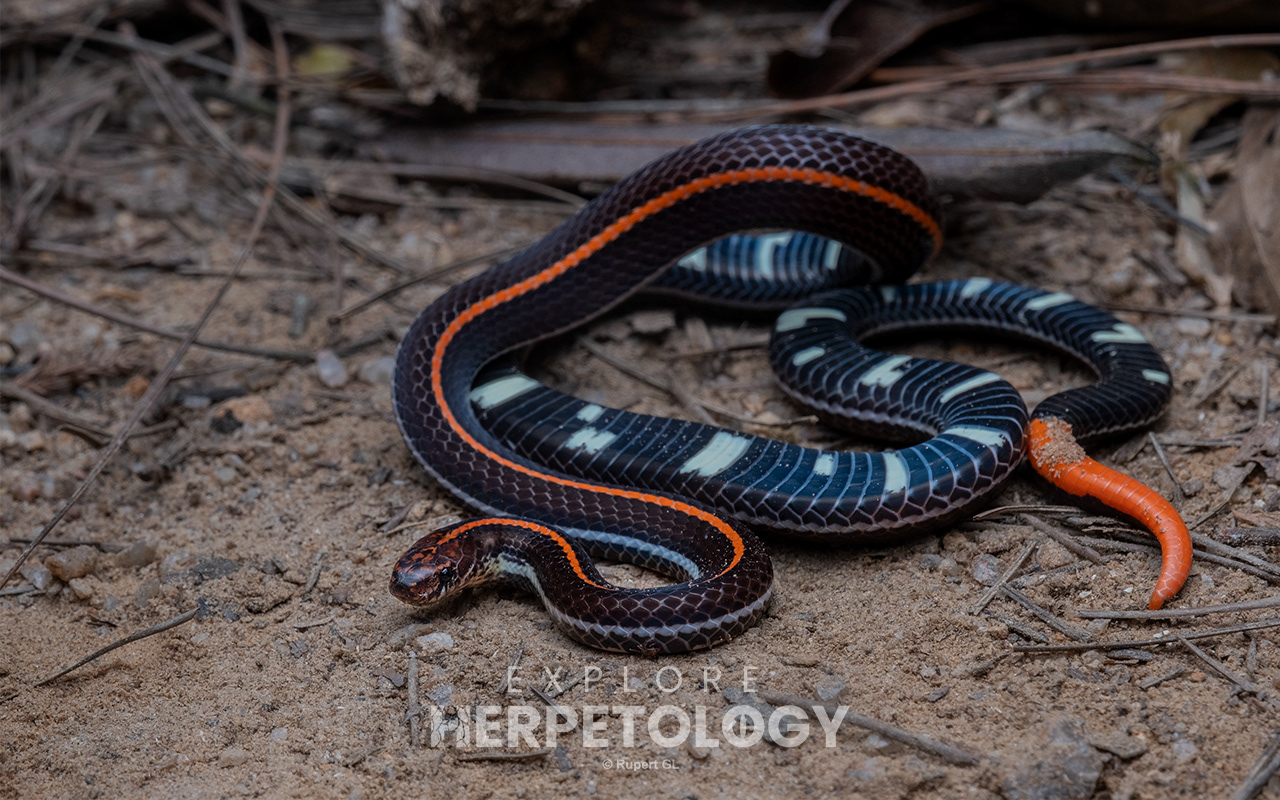
Malayan banded coral snake (Calliophis intestinalis)
The following morning began in the same vein, with some unbelievable luck. Firstly, Steven caught a speckle-bellied keelback (Rhabdophis chrysargos) on the edge of a jungle trail, before Jordan spotted a huge Jasper cat snake (Boiga jaspidea) resting in the rafters of a rest hut. Jasper cat snake had been our white whale species on our herping expeditions, so far evading us on every single group tour we've run. Not this time! We also got up close to a group of Siamang, a very special encounter.
We tried the lowlands that night, but it was very dry and somewhat unproductive. We did see a big Malayan racer (Coelognathus flavolineatus), a juvenile reticulated python (Malayopython reticulatus) and a couple juvenile Wagler's pit vipers (Tropidolaemus wagleri). Another cool find was a cat gecko (Aleuroscalabotes felinus), one of the most charismatic lizards in the region.
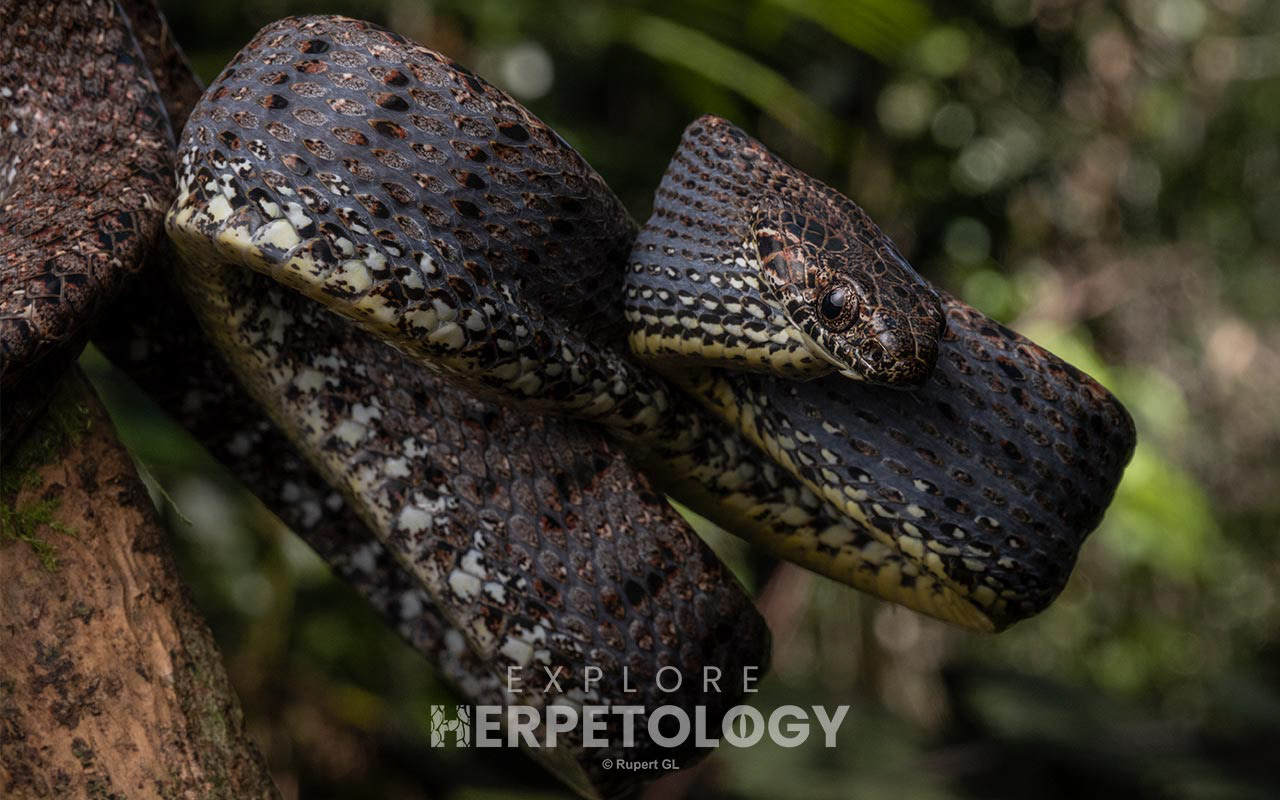
Jasper cat snake (Boiga jaspidea)

Speckle-bellied keelback (Rhabdophis chrysargos)

Photography shortly after finding Boiga jaspidea
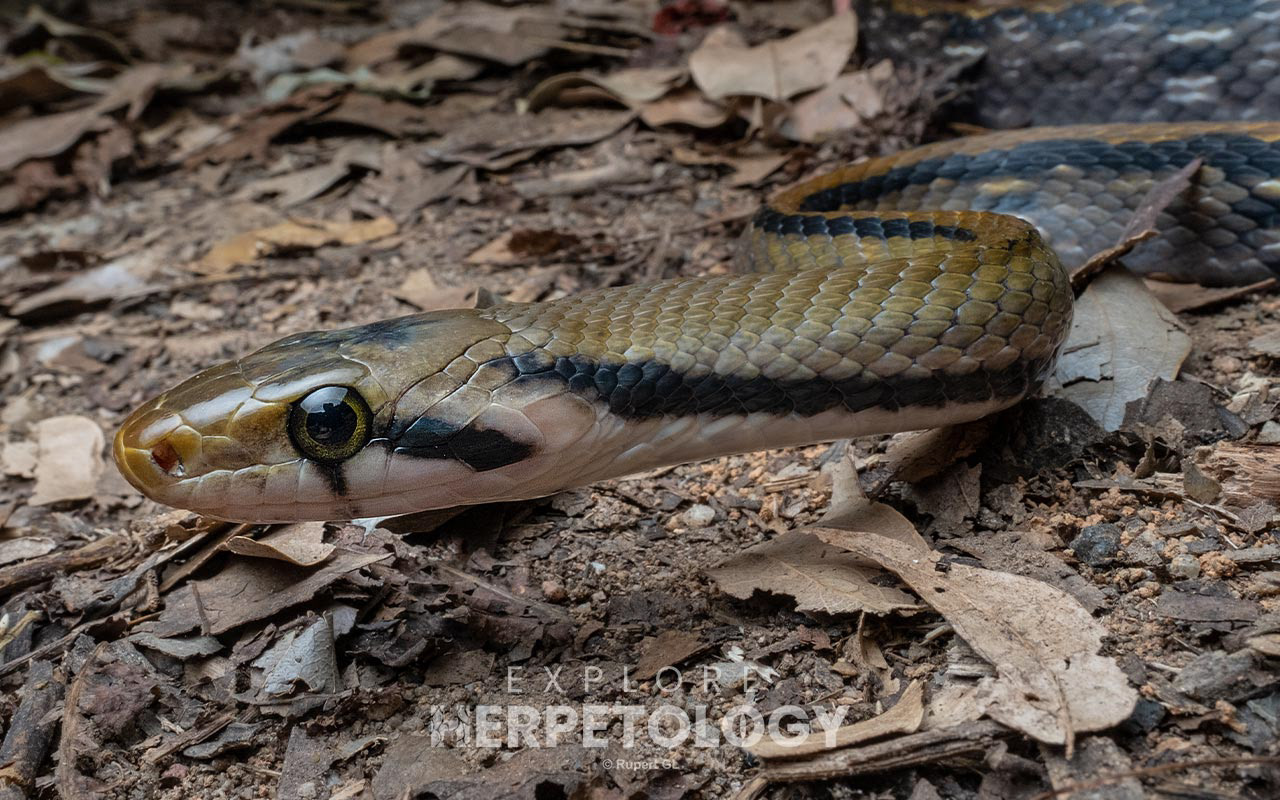
Malayan racer (Coelognathus flavolineatus)
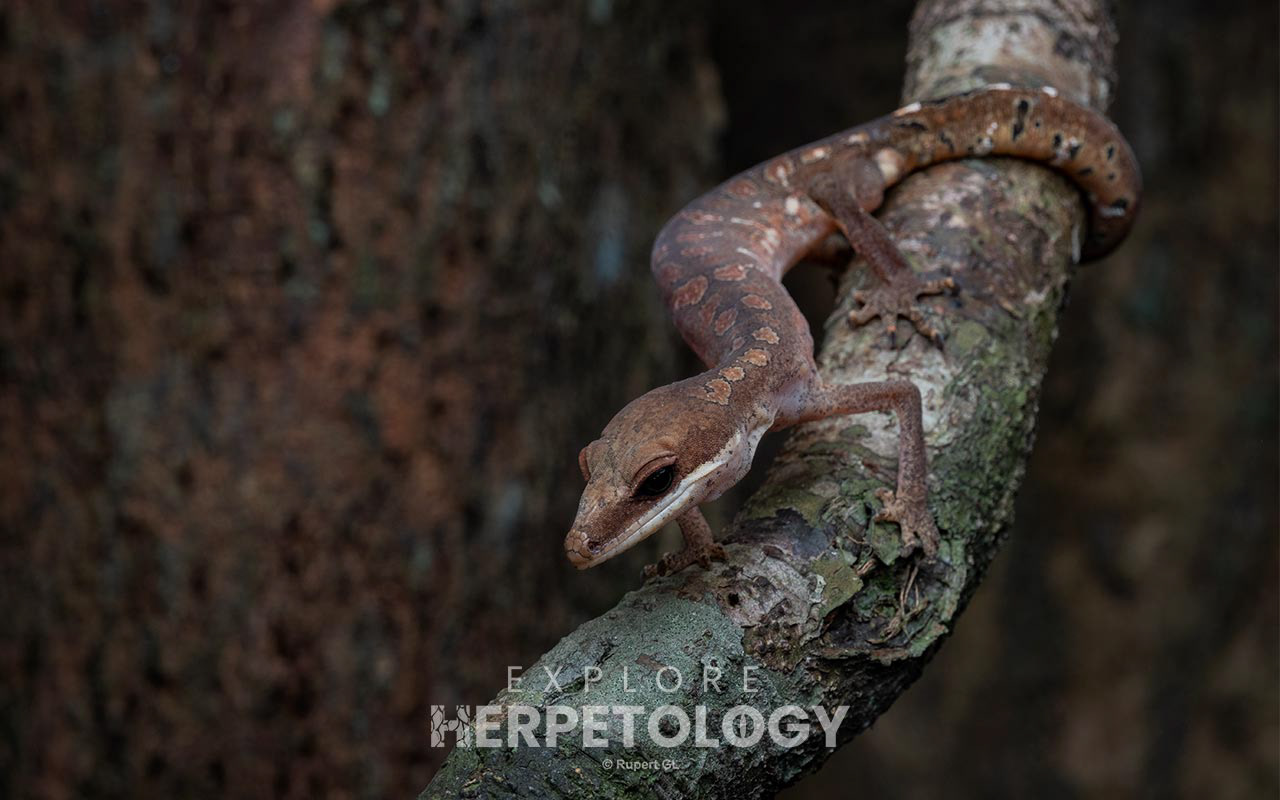
Cat gecko (Aleuroscalabotes felinus)

Left to right: Abavorana luctuosa, Coelognathus flavolineatus, Actias maenas
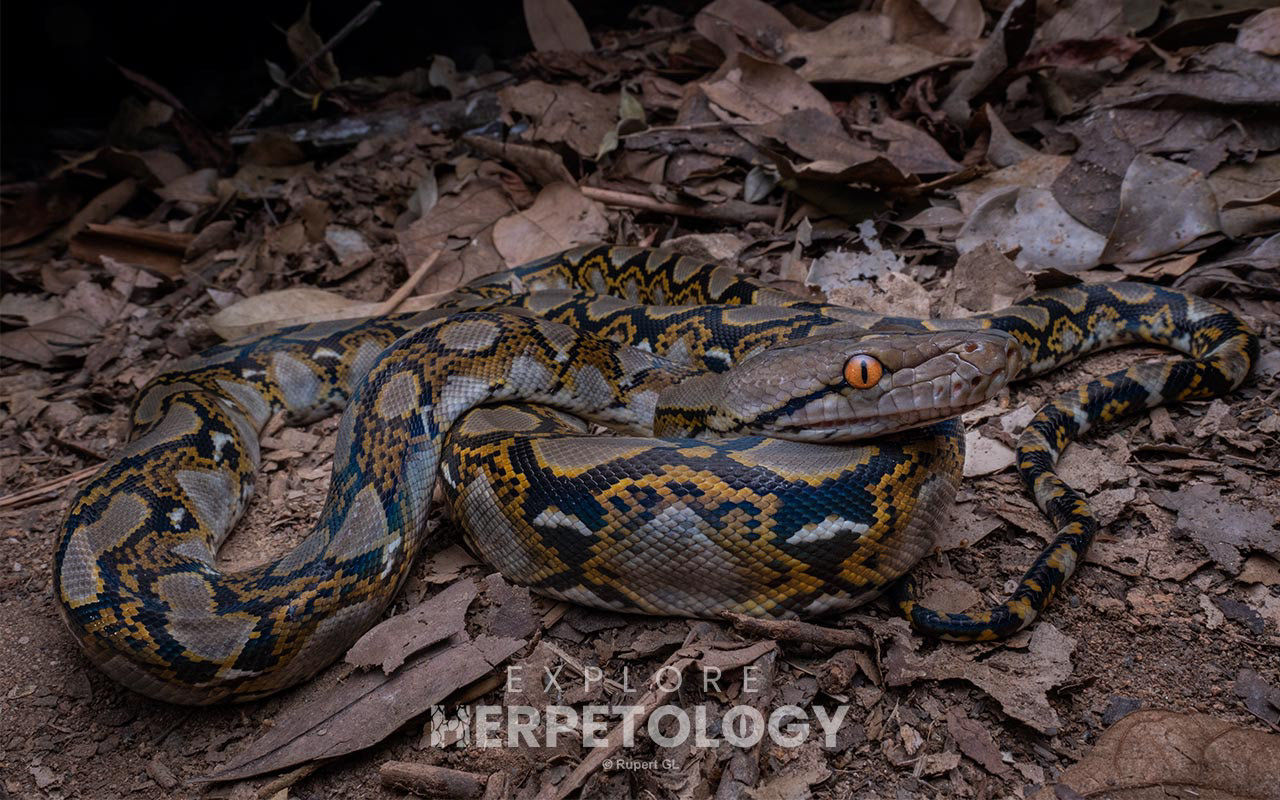
Reticulated python (Malayopython reticulatus)
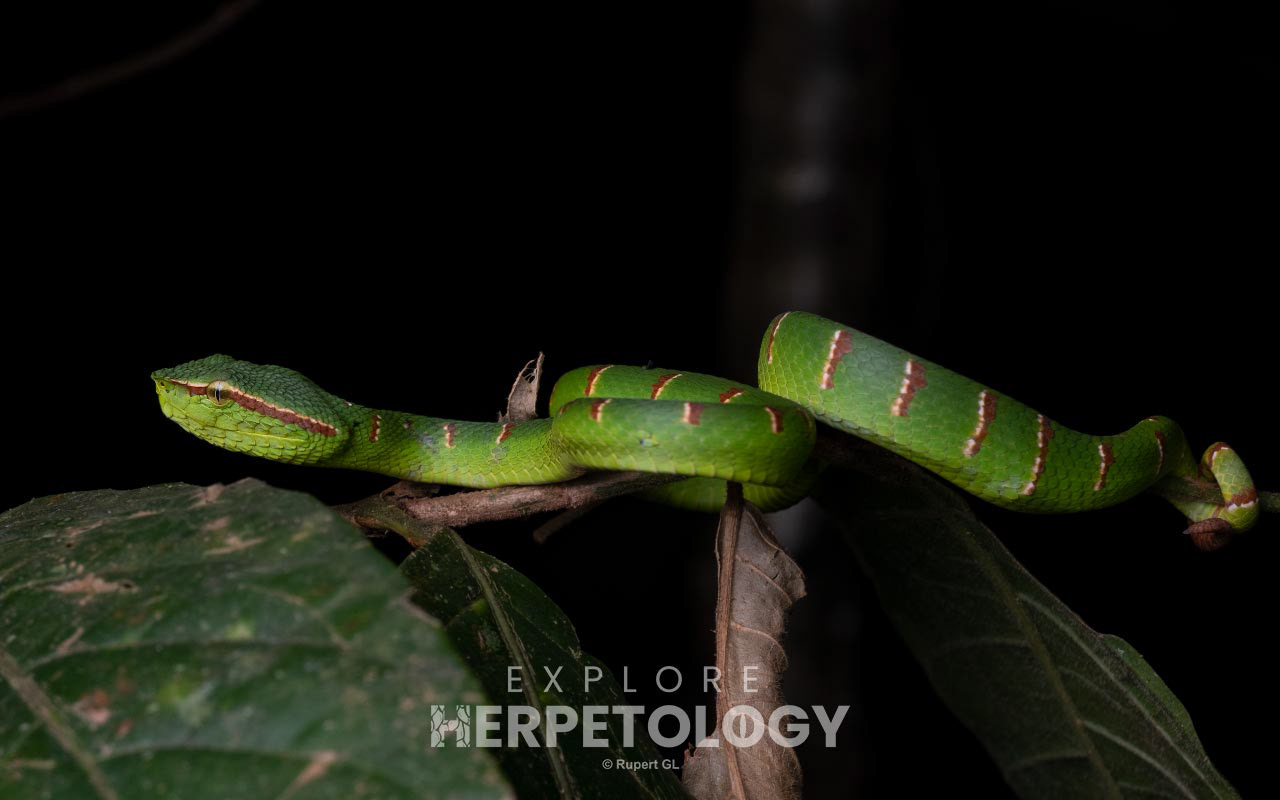
Wagler's pit viper (Tropidolaemus wagleri)
We went for another daytime walk on day 3, focusing on combing through leaf litter for high elevation fossorials. This was successful as always, especially as our resident gnome Plato put his digging skills to work and turned up a juvenile Schlegel's reed snake (Calamaria schlegeli), a Low's reed snake (Calamaria lovii) and a blotched forest skink (Sphenomorphus praesignis). A fantastic haul for a short daytime outing!
The night herping was relatively slow on our penultimate night, but we were extremely happy with a pair of red mountain keelbacks (Hebius sanguineum), a generally rare species which has recently been showing up at Bukit Fraser frequently around a few small streams. We also found a juvenile white-spotted cat snake (Boiga drapiezii), a dwarf reed snake (Pseudorabdion longiceps) and a handful of Sabah pit vipers (Trimeresurus sabahi).

Left: Sphenomorphus praesignis. Right: Calamaria schlegeli
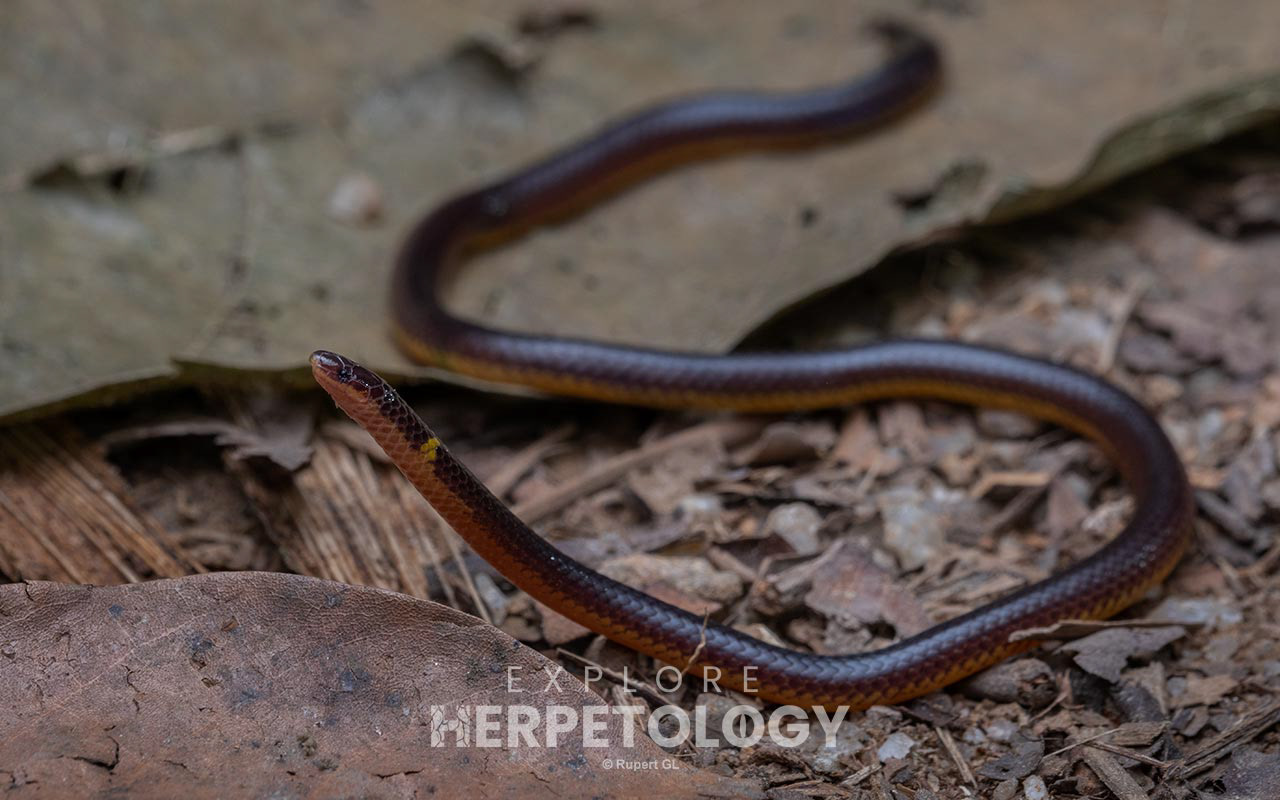
Low's reed snake (Calamaria lovii)
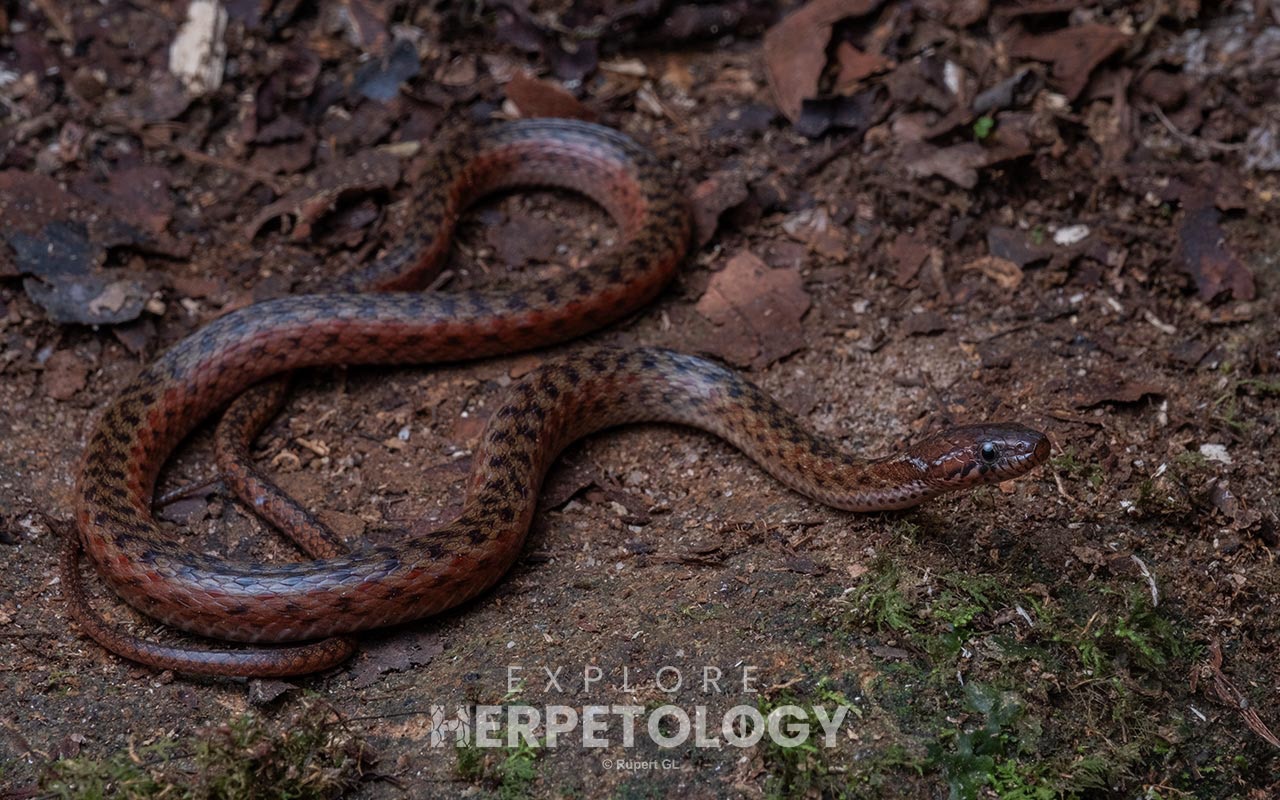
Red mountain keelback (Hebius sanguineum)
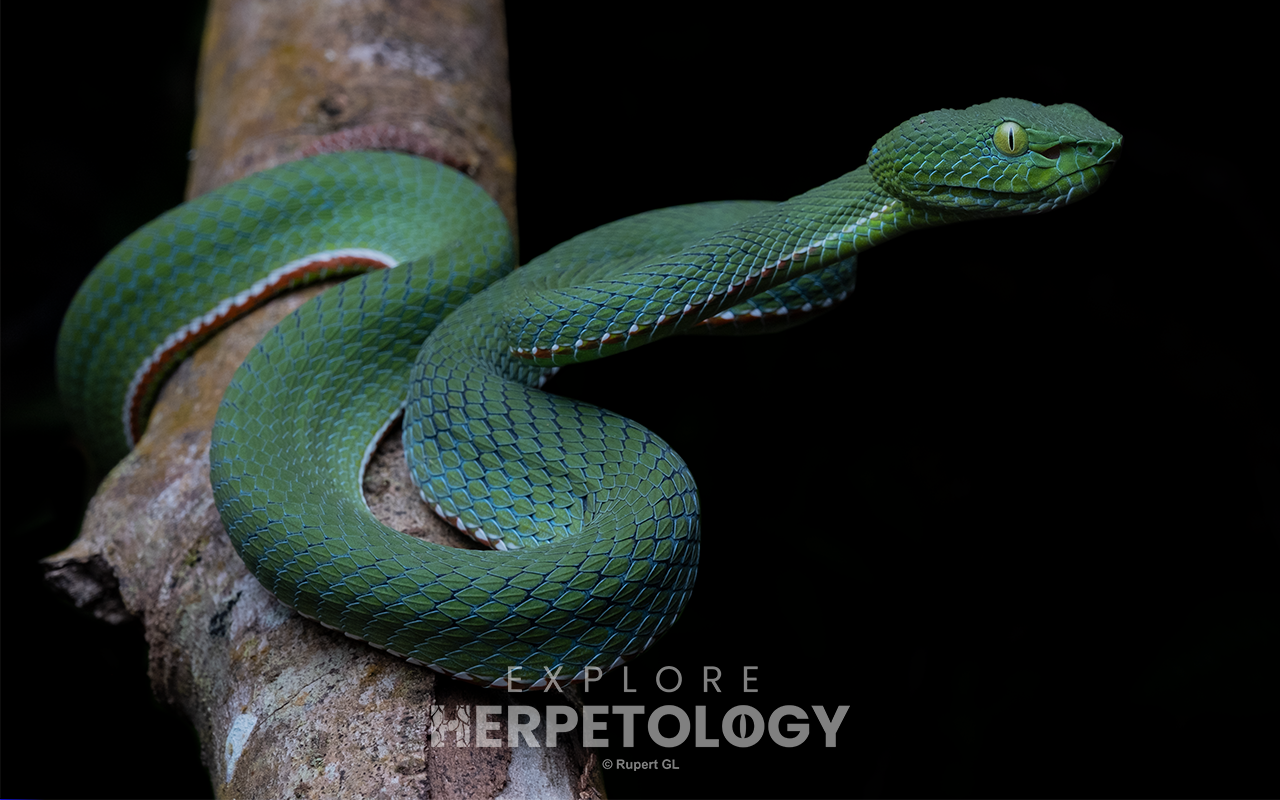
Sabah pit viper (Trimeresurus sabahi fucatus)

White-spotted cat snake (Boiga drapiezii)

Left: Hebius sanguineum. Right: Pseudorabdion longiceps
Now is a good time to appreciate the group and good 'vibes' we had on this trip. Everyone was so enthusiastic and yet easy-going at the same time, getting involved with our unique humour and fully investing in our extreme style of herping. Pictured below are a few images in tribute to the group and the good times we had together.

The 'banter bus' is visible here.
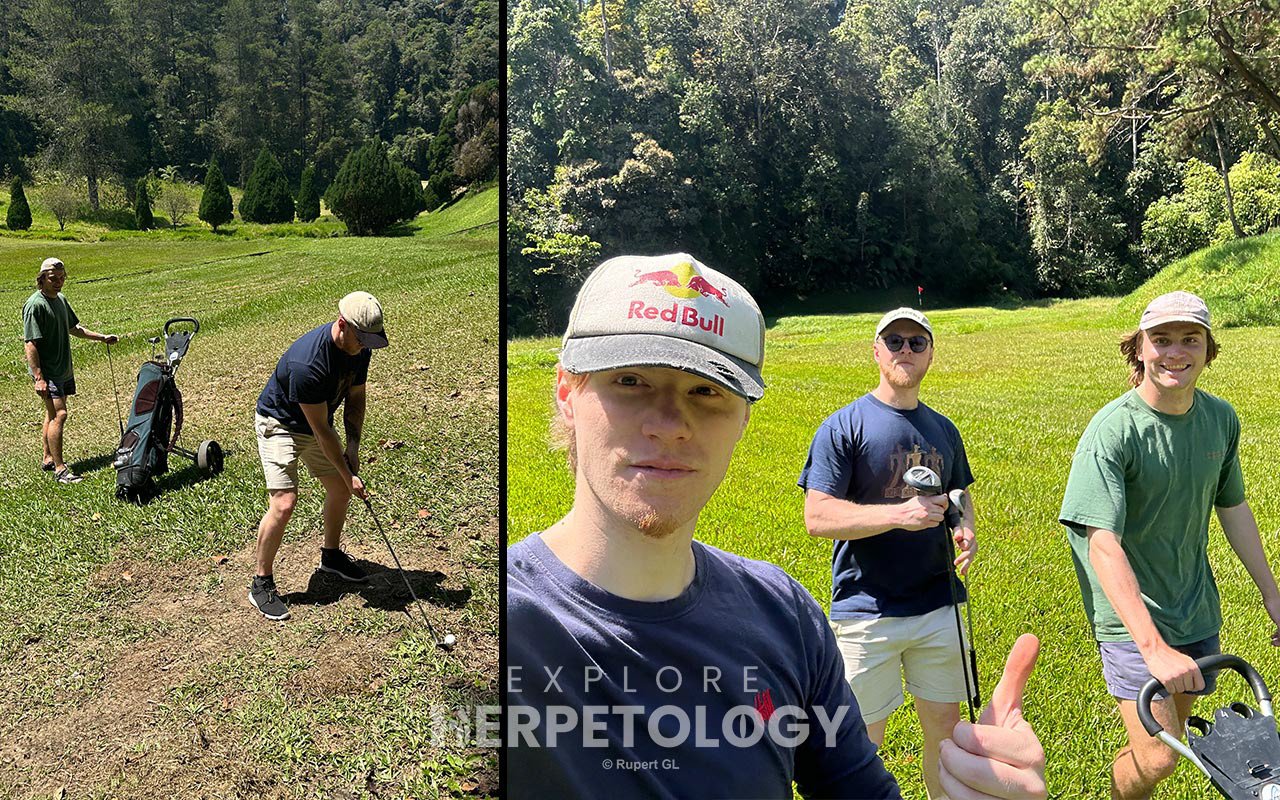
A few holes on the worst maintained golf course.

Plato (left) and Stefan (right)

The whole Expedition Malaysia group.

The Barely Schlegel Boys
Having already had an exceptional trip so far, we decided to spend our final night less divided into small groups than previous nights, enjoying some easy walking around the mountain roads and good company. Lucky for us, snakes were active and we found two Malayan banded coral snakes (Calliophis intestinalis), a blue bronzeback (Dendrelaphis cyanochloris), a Chan-ard's reed snake (Macrocalamus chanardi) and the usual selection of Sabah pit vipers (Trimeresurus sabahi fucatus). Some other herpers in the area found a blunt-headed slug snake (Aplopeltura boa) and large adult white-spotted cat snake (Boiga drapiezii) which they shared with us. The extremely dry weather had made frogs hard to come by, but we saw a few awesome pied warty frogs/bird poop frog (Theloderma asperum) this evening.
Just before wrapping up, we had some of our coolest finds of the trip. Firstly, my group accidentally disturbed a leopard cat which was attempting to kill a bamboo rat. The leopard cat momentarily ran away but continued watching from a small distance, undoubtedly coming back to finish its kill when we left. Next, we discovered a juvenile Butler's wolf snake (Lycodon butleri) which was predating a Bukit Fraser forest skink (Tytthoscincus bukitensis) and watched the entire process of it feeding. Meanwhile, Steven's group found the strange and extremely rare Leonard's dwarf pipe snake (Anomochilus leonardi). A fantastic selection of encounters to end a trip full of excitement and rarities.
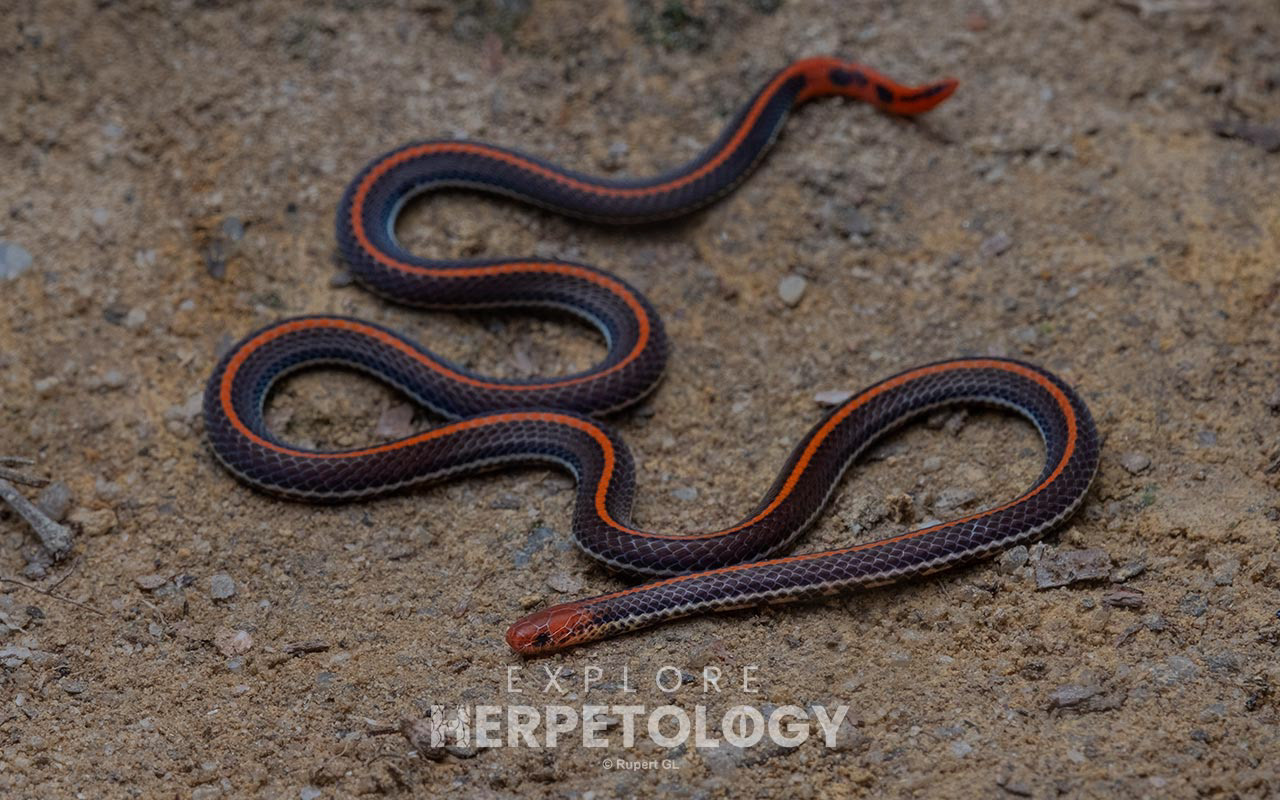
Malayan banded coral snake (Calliophis intestinalis)
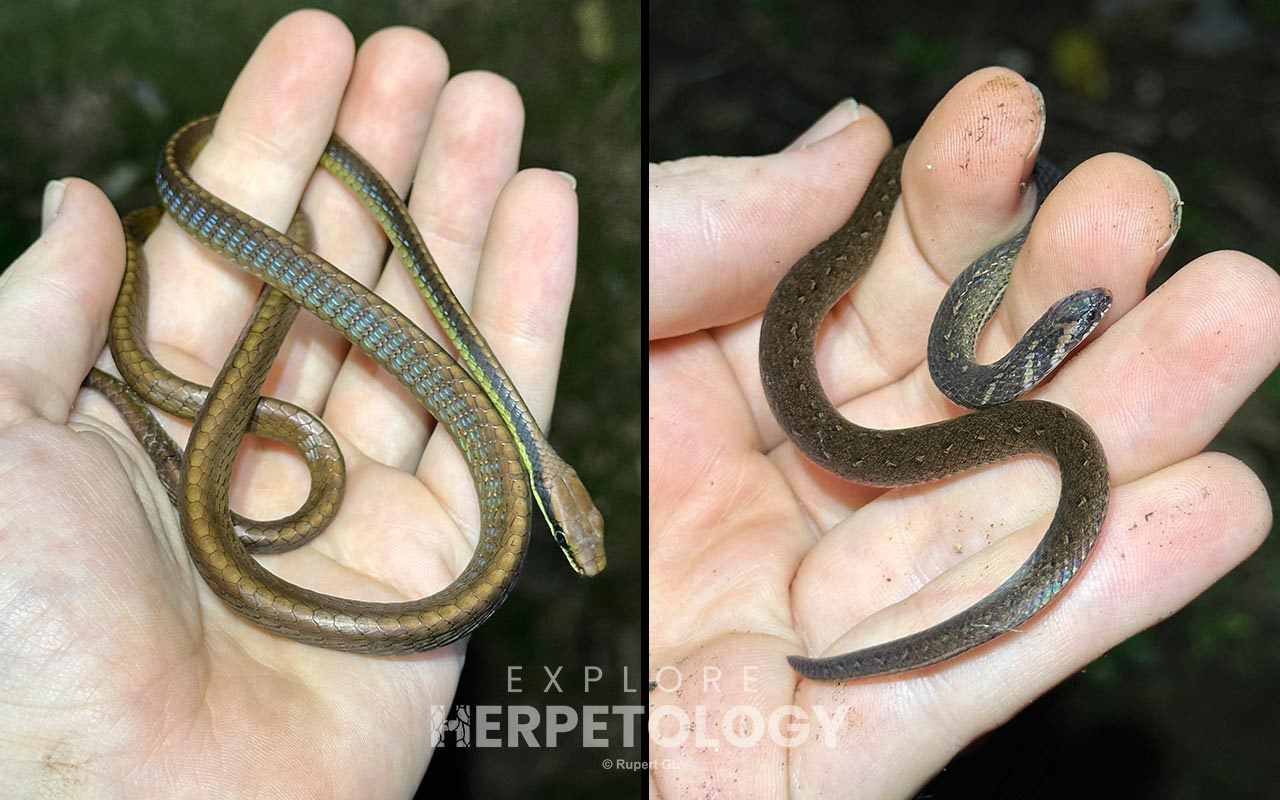
Left: Dendrelaphis cyanochloris. Right: Macrocalamus chanardi.
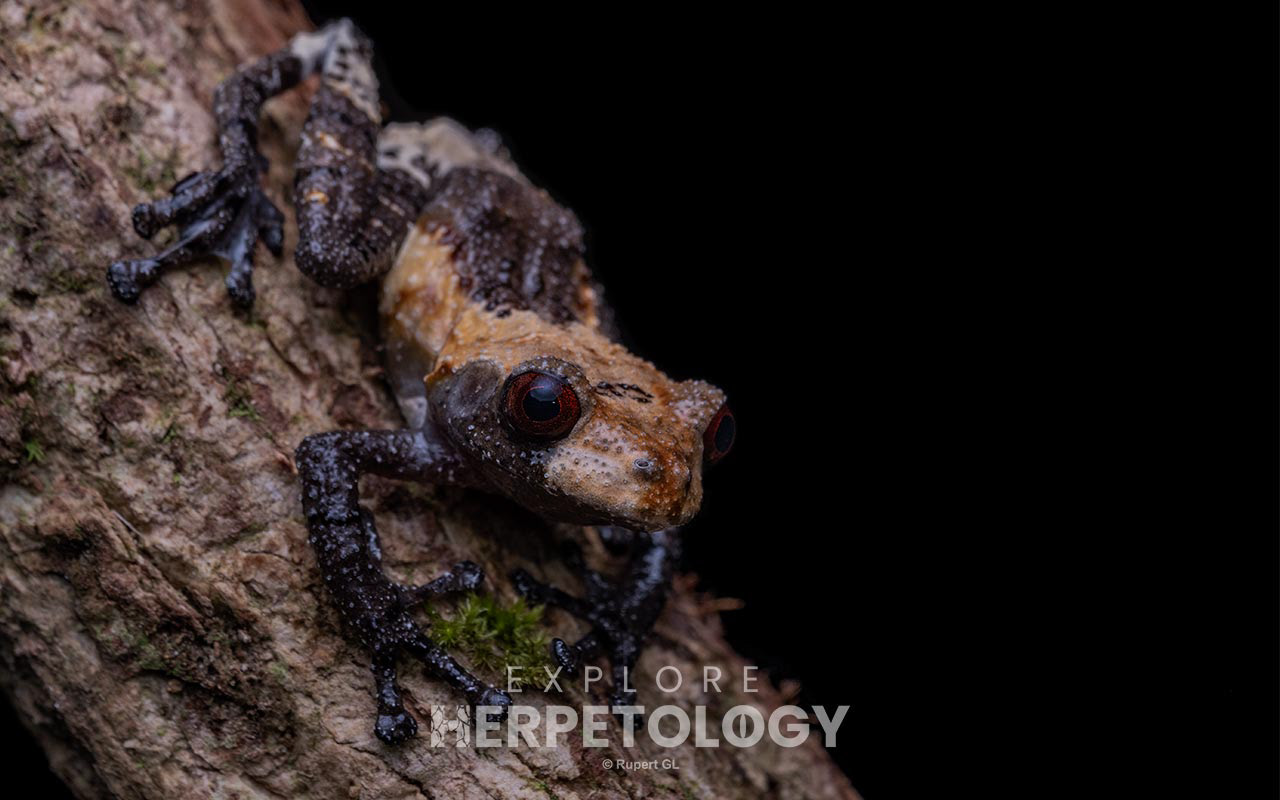
Pied warty frog (Theloderma asperum)
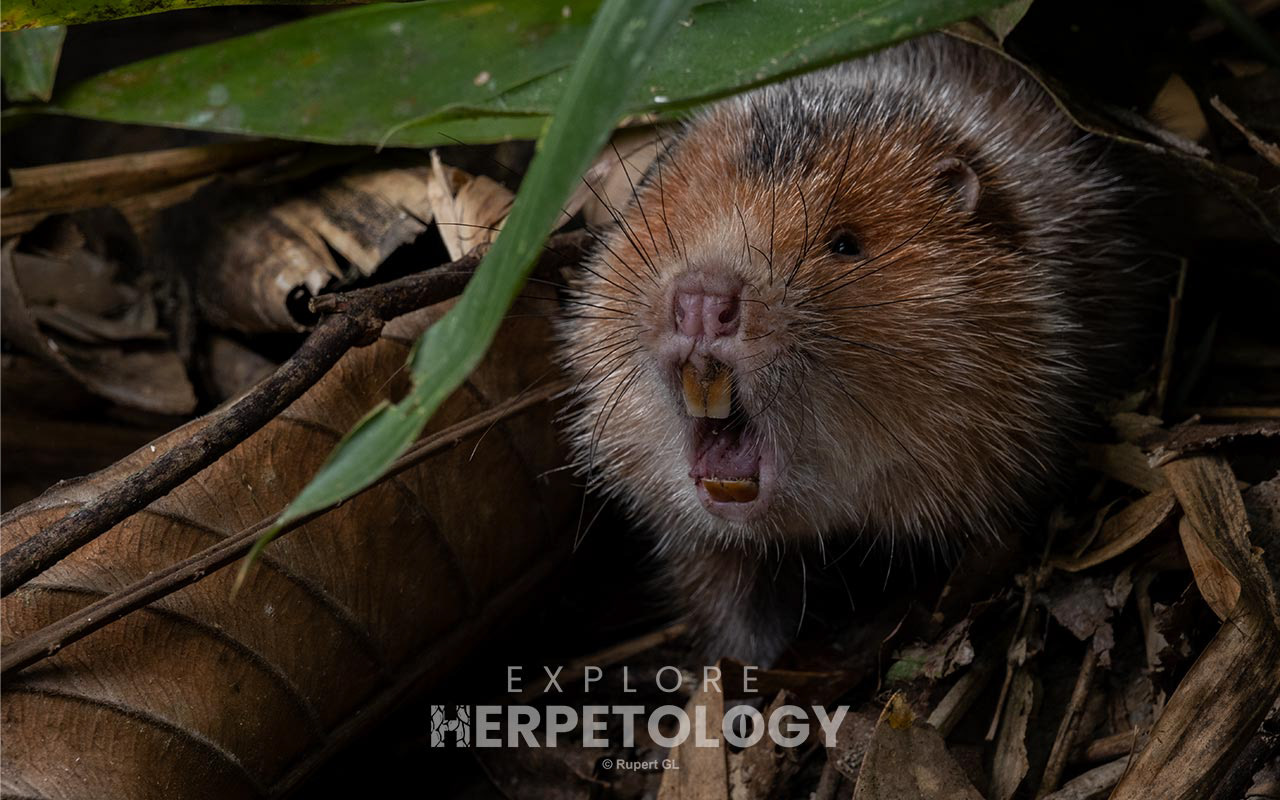
Bamboo rat
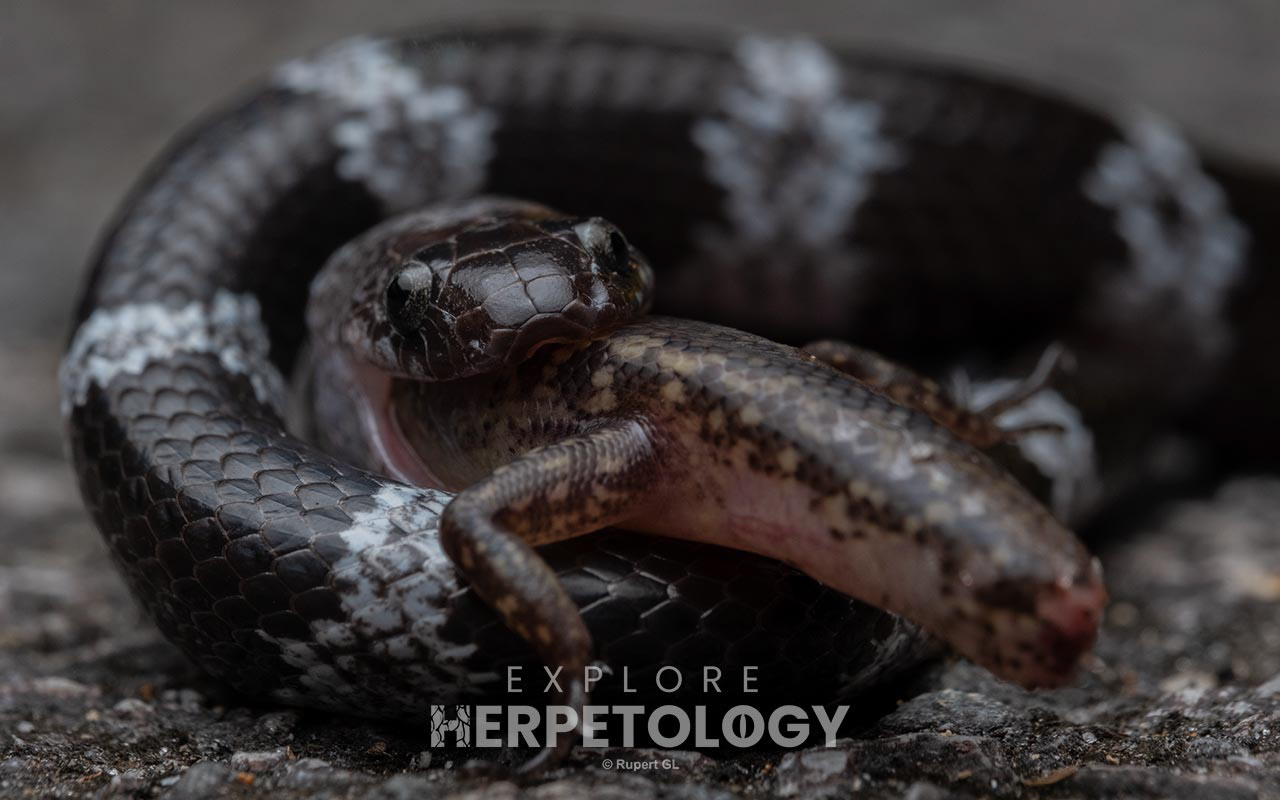
Butler's wolf snake (Lycodon butleri) predating Tytthoscincus bukitensis
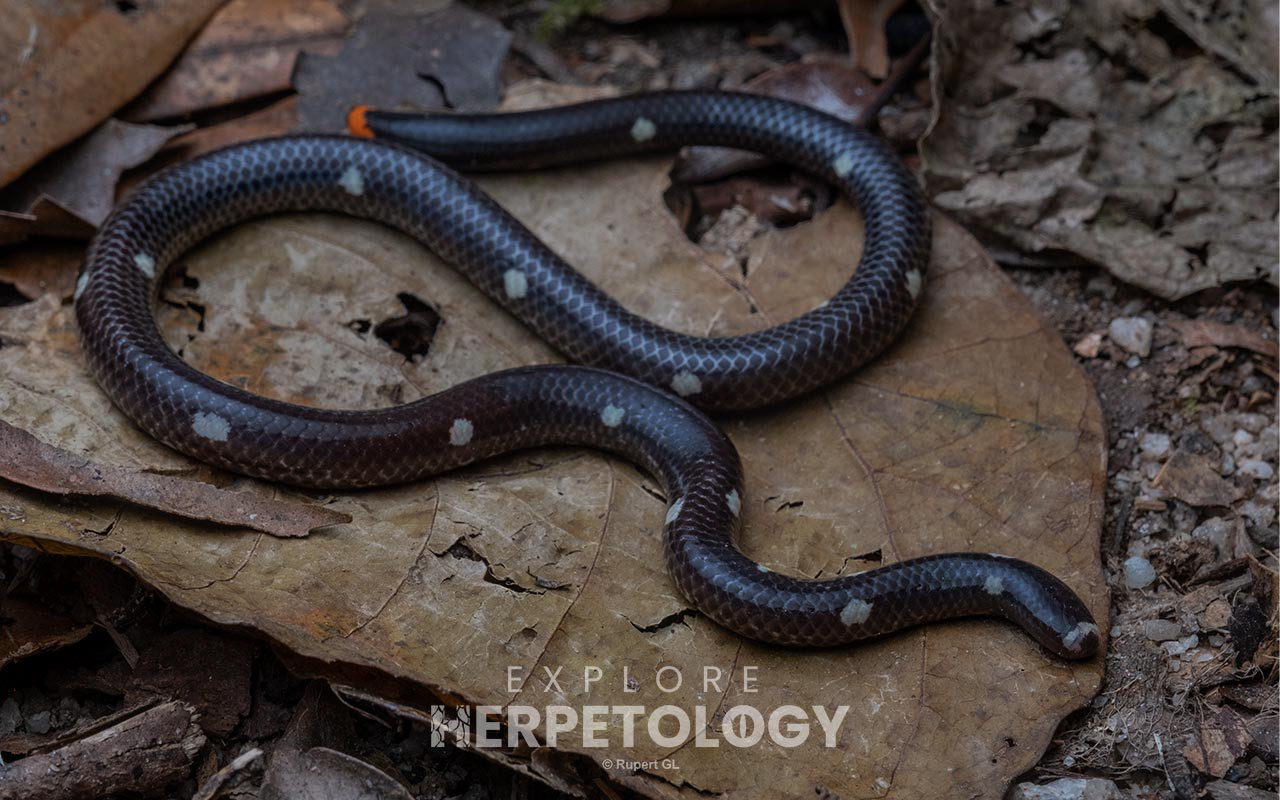
Leonard's dwarf pipe snake (Anomochilus leonardi)
Sadly, that was the end of 10 days which went extremely fast. The changes of location and rapid rate of snake encounters made sure of that. We were very happy with the turnover of numbers. Sure, effort levels were far from low. As mentioned before, our group had unlimited energy to split up and cover as much ground as possible, but regardless, we have seen far lower levels of productivity during our team's previous years of herping in these areas.
Next year, we are bringing back this expedition following the same format. However, it will take place a few weeks earlier in the year during what we predict to be the latter end of the rainy season, mixing up conditions and hopefully leading to even higher levels of activity - especially with our viper targets. Want to join? Book here!


